How to Use Subheadings in Your Essay: A Step-by-Step Guide

Subheadings are essential tools for organizing and presenting content in a clear, engaging manner. Whether you’re drafting an academic paper, a report, or a blog post in Google Docs, effective use of subheadings can make your writing more readable and structured. This guide will walk you through the process of using subheadings in your essay, helping you enhance your content's clarity and impact.

1. Understand the Purpose of Subheadings
Before diving into the mechanics, it’s important to understand why subheadings matter. Subheadings break up your text into manageable sections, making it easier for readers to follow your argument and locate key points. They provide a roadmap of your essay, ensuring that each section contributes to your overall thesis.
2. Plan Your Essay Structure
Begin by outlining your essay. Identify the main sections you need based on your thesis and arguments. Common essay sections include the introduction, main body (with various arguments or points), and conclusion. Each of these sections should be broken down further into sub-sections as necessary. For example, in a persuasive essay, you might have subheadings for different arguments or evidence supporting your thesis.
3. Create Subheadings in Google Docs
To add subheadings in Google Docs:
- Open Your Document : Launch Google Docs and open the document you’re working on.
- Select the Text for Your Subheading : Highlight the text you want to use as a subheading.
- Apply a Heading Style : Go to the toolbar at the top of the screen. Click on the styles dropdown (usually showing "Normal text") and select the appropriate heading level (e.g., Heading 1, Heading 2). Heading 1 is typically used for main sections, while Heading 2 and Heading 3 are used for sub-sections.
- Adjust Formatting as Needed : You can further customize the appearance of your subheadings by changing the font size, color, or style from the toolbar.
4. Use Subheadings to Guide Your Reader
Ensure that your subheadings are descriptive and relevant to the content they precede. They should provide a clear indication of what the reader can expect in that section. Avoid vague subheadings; instead, opt for specific, informative ones that accurately reflect the section’s content.
5. Maintain Consistency
Consistency is key in using subheadings effectively. Stick to a uniform style and format throughout your document. This helps maintain a professional appearance and ensures that your essay is easy to navigate. For example, if you use Heading 1 for main sections, consistently use Heading 2 for subsections throughout your essay.
6. Review and Edit
After applying subheadings, review your document to ensure that they are logically placed and that they enhance the readability of your essay. Check that each subheading accurately reflects the content of the section it introduces and make adjustments if necessary.
1. Why should I use subheadings in my essay?
Subheadings help organize your content, making it easier for readers to follow your arguments and understand the structure of your essay. They break up large blocks of text, making your writing more engaging and accessible.
2. How do I choose the right subheading style in Google Docs?
In Google Docs, use Heading styles (Heading 1, Heading 2, etc.) to create a hierarchical structure. Heading 1 is for main sections, while Heading 2 and Heading 3 are used for sub-sections. This helps in organizing content and creating a table of contents if needed.
3. Can I customize the appearance of subheadings?
Yes, Google Docs allows you to customize the font size, color, and style of your subheadings. You can modify these settings through the toolbar to match your preferred formatting style.
4. How many levels of subheadings should I use?
The number of subheading levels depends on the complexity of your content. For most essays, two or three levels of subheadings are sufficient. Ensure that your subheading hierarchy is logical and easy to follow.
Join Docswrite.com Blog mailing list
No spam. Pinky promise

Should you Include Headings and Subheadings in an Essay?

If you have ever tried reading a large blob of text, then you know how hard it can be. However, it becomes easier to read when broken into headings and subheadings.
Academic writings like essays have a standard of writing that must be upheld. While not every essay requires headings and subheadings, they are important for organizing your writing.
Headings describe the succeeding section, while subheading gives supporting information for the heading.
With that said, here is everything you need to know about headings
What are Headings in Essays and Academic Papers?
According to Merriam-Webster, a heading forms or serves as a head.
In academic writing, headings represent what is to come in the assignment. Adding a heading will help structure a piece of writing and guide the reader throughout the content. Short pieces of writing don't always require headings. In long-form writing, each specific section should have its heading to communicate what the reader should expect clearly. Think of it as the title of that section.
Since some points are more important than others, the heading chosen should be based on whether the idea you are talking about is the main point. Each heading chosen should tell the reader what the following idea is about. This is because the main points are the building blocks of the content. Make sure it is short, descriptive, and precise.
You can include headings and subheadings/subtopics in an essay if it is long, but ensure that the subtopics or subheadings are relevant to the content and consistent throughout the text in a manner to contribute to your thesis statement. As a good practice, ensure that the essay headings and subheadings do not exceed 12 words.
Subheadings are not recommended for short essays . However, they improve the overall structure of a long essay, help you frame and explore your topic, and enable the readers to know what to expect (they act as signposts in an essay or research paper).
Heading vs. Title
Headings and titles may look similar at a first glance, but they are not. A title represents the entire paper and explains it in clear and short phrases. It is the first thing the reader will see and determine whether they read the rest of the document. For this reason, you need to think of striking, informative, and appropriate titles. You should also write the title based on why you are writing that document. For instance, if the aim of the documents is tutorial, then the title should be task-based.
On the other hand, a heading represents what each section of the paper discusses. They help guide the reader throughout the documents, which is why you should write effective headings, and they should be as descriptive as possible.
Headings are a requirement in most forms of writing, but some lecturers may be divided about using them in academic essays, which is why you should confirm with them first.
Headings Vs. Subheadings
Headings are key parts of writing as they will capture the reader's attention and lure them into the document's purpose. They guide the reader to the main points of the paper. You have to set the headings apart from the body of the text by coming up with an enticing phrase.
Subheadings, on the other hand, do more than grab the reader's attention; they show the different subsections of the text. They keep the reader engaged by quickly guiding them to the information they want.
Headings and subheadings appear at the beginning of a section and organize the flow of the documents. In addition, they are both used to break down large blocks of text to make them more scannable. They also have a hierarchy that is Heading (H2) first, followed by subheadings (H3) and (H4) in that order. Subheadings should always come after the heading, as demonstrated.
The Best Length for Headings in Academic Writing
A heading can be as long as you want it to give the reader a snippet of the idea. A good rule of thumb should be no more than 70 characters.
For higher level headings, like H1, H2, and H3s, they could be as low as one word, for instance, the introduction, methodology, and such. For such sections, the one word is clear enough for the reader to know what it represents. Low levels like H5 and below can be much longer and direct the reader to exactly what they are looking for.
Levels of Heading in Academic Writing
Headings are an important part of academic writing as they act as a preview of the document. They guide the reader on what you are talking about, which is why you should assign different heading levels.
There are five levels of headings in APA style. Level 1, Level 2, level 3, level 4, levels 5. Level 1 is the main heading, followed by level 2, its subheading, and level 3 is the subsection of level 2 in that order.
Level 1 headings are your main headings and are usually typed in the center of the paper in title case and bolded. Their text beneath will always start in the next line, indented inward, just as you begin a new paragraph. These help the reader find their way through the document, read what they want and skip what they are not interested in.
The length and complexity of the paper will determine how many levels you will use. If it's just a short piece of writing, you can use Level 1. If you need two headings, use level 1 and level 2. If it's a 2000-word article, research paper, term paper, or essay, you will need between 3 and 5 headings.
Keep in mind that not every paragraph needs a heading. While headings can keep your work neat, too many can defeat the purpose. Also, make sure that each of the headings and subheadings has a connection to the main title.
All these levels are differentiated by different styles and formats depending on the publication manual provided, which can be either APA or MLA format.
Reasons to Use Headings in Academic Writing
Headings are helpful in academic writing for a myriad of reasons, including:
Making Your Content More Readable
Much information goes into academic writing to pass information to the reader. Putting all your information in a large block of text will be overwhelming and can scare away the readers. The white gaps at each heading section will offer a resting place hence a visual break. Therefore, separating the large chunks of text into manageable portions will keep your readers engaged.
Outlining Your Content
Headings serve as the structure of your writing. By dividing the large bulk of text with headings, you guide the reader through each section and what it is about. Otherwise, they won't know what it is about.
Capturing the Reader's Attention
The main aim of any heading is to hook the reader and create curiosity enough for them to continue reading through the rest of the article. Having a catchy and informative heading will entice them to read even further.
Remember that readers rarely read documents from start to finish. Major headings should stand out but so should headings and subheadings if you want the readers to continue reading your paper.
Finding Important Information
Readers will likely scan the essay to get a general idea of what it is about and decide if they want to read it. Well-structured headings will help them achieve that.
Improving Overall Quality
Headings and subheadings improve the quality of the essay. A high-quality essay is suitable for readers and also for search engine optimization (SEO) if you intend to publish it online. Ensure to use keywords in the headings and structure them to improve visibility.
Tips to Include Better Headings and Subheadings
Writing informative and precise headings and subheadings is vital if you want your writing to get the message home. You need to borrow the following tips to show that they should spend time reading your writing.
Use the Right Length
The length of your article or essay will determine how long your headings and subheadings should be. Put yourself in the reader's shoes and think of the heading you would like to read. Lengthy headings aren't attractive. Most readers want something short and precise, which is what you should do. It should only take them a few seconds to read, so be sure the length should be not more than 30 words.
Make It Relevant to the Content and Topic
Headings and subheadings are essential to catch the reader's attention but are not important enough to stand independently. They represent the critical concepts and all the supporting ideas. Therefore, you need to consider the topic's relevance when determining what phrases to use in your subheading. Carefully think about each key piece of information you'd like to include in each of your sections. Then ensure that each subheading is connected to the main title or the heading.
Be Clear and Concise
Headings and subheadings tell the reader what the content is about. They are usually about five words long. Therefore, you should go directly to the point using clear language that is easy to understand. Most readers skim through the text before reading which is why you should use simple and straightforward words. Always remember that readers have questions and are looking for answers and shouldn't have to ponder what you are talking about. If your heading is clear and to the point, they won't leave to look for answers elsewhere.
Place It in the Right Place
Consider where your target audience is likely to look and where they are likely to appear. While doing this, also consider the kind of phrases they are likely to type for the specific information they want. This gives you a general idea of where to place headings and subheadings. Remember that the APA and MLA format requires that all headings be placed hierarchically. So as you choose your phrases, ensure that they align with the content's topic and flow.
Consider the Formatting Style
Heading styles format your headings to make them stand out from the rest of the text. They also give your essay structure and make it more accessible to the target audience. In addition to this, headings also help in:
- Generating a table of contents
- Use style sets to reformat the document
- Rearranging the documents
- Creating a structured pdf file using the heading tag
Remember that each heading is formatted with a different heading style located in the style section. Since you've already used H1 for the major heading, the first subheading will be H2, and the second subheading will be H3.
Related Reading: How to indent an essay well.
Number the Heading or Subheading if Needed
Putting numbers on your heading makes it easy to scan. Top-level headings like H1 are numbered 1,2,3,4 while second-level headings, like H2, are numbered 1.1, 1.2, 1.3
Remember that even though you are numbering the headings, you need to introduce your topic in the first paragraph after the headings. Headings don't speak for themselves, so writing a few sentences restating the main idea will tell the reader what will come.
Be Consistent Throughout the Paper
If you intend to use headings in your paper, ensure each section has a heading and subheading. Also, ensure they are consistent in font, size, color, indentation, etc. The style function in Microsoft Word will help create consistency in your headings. You must select the text you want to convert into a heading, then select the appropriate heading from the Style box.
Avoid Repetition
Avoid repeating any phrases in your headings. Using the same heading more than once can affect the reader's comprehension of your message, negatively impacting their reaction to your essay. Sometimes you may repeat the headings without even noticing. For this reason, you should use the Find Function in MS Word or Google Docs.
Another way you can check for repetition is by reading your essay out loud, and this will help you spot any headings or subheadings that have been repeated.
Capitalize, Format, and Punctuate Well
Effective headings are well capitalized, formatted, and punctuated. The APA style uses two styles for this, title case and sentence case. In the title case, major words are capitalized, while minor ones are lowercase. Sentence cases, on the other hand, only capitalize the proper nouns while the rest remain in lowercase.
Use Automatic Heading in Word Processor
Microsoft Word has a built-in feature that anticipates how you want to format your document. As you begin typing, your text starts in the typical style, but when you press enter and move to a new line, the style changes to H1 with different fonts, colors, etc.
If you are typing a paragraph with a small number of words and press enter and then fail to provide proper punctuation, the feature will assume you are moving to a new paragraph, and it will then automatically enter a new heading with a heading style.
Use Descriptive Headings
Use concrete and descriptive language to make your headings more effective so the reader can know what to expect in each section. Don't use function headings when writing your technical reports; these are not so predictable, and readers benefit from the headings being much more descriptive.
Function headings are only used when writing pieces that need consistent structures, for instance, lab reports. An example is:
- Introduction
- Methodology
- Conclusions
Include Technical Terms Needed
Technical terms should not be used in headings because they may be hard to understand except those who know the languages. Technical terms are primarily used in academic documents that professionals read but if not specified, avoid them.
Related Read: How to write an article title in academic papers.
Final Words
Headings and subheadings are vital features in academic writing that represent the main points of a topic. The difference in formatting helps reader's the main points from the rest of the texts. Ensure you follow all the tips about including headings and subheadings in your text. Talk to your lecturer, professor, teacher, or instructor if you are unsure whether to add them to your essay.
What are Headings in an Essay?
Headings are markers that guide the reader through an essay by showing them what the next section is about. Like a title, they are only a few words long and are essential in structuring your content so as not to overwhelm the reader.
Should I Put Headings in an Essay?
Yes. It will help if you put headings in your essays to make them more readable. Essays consist of three parts: introduction, body, and conclusion. Most of them are written in a continuous, paragraphed text without the need for section headings, especially if it's a short essay. On the other hand, long-form essays need headings and subheadings to make them easy to write and read. Since most lecturers are divided about using them in academic essays, you should confirm with your tutor before you start writing.
How Do I Include Subheadings in an Essay?
Subheadings are mini headlines that come after the headings, and they help explain more about the headings and aid readers in skimming through the content. If you have used the first heading, H1, and need to provide more information about it, add a subheading, H2.
If you have trouble deciding how to use subheadings correctly, think of them as an outline. Therefore, break down your topic into simple ideas, then use them to organize your essay.
How Do You Make a Heading in an Essay or Academic Paper?
You must think carefully about the aim of writing a paper and the main idea. Each heading should be clear and to the point. You don't want to mince words and possibly confuse the reader. Also, remember that headings are meant to enhance, not replace, the main topic. Ensure you set it apart from the body of the text by using H1 formatting in either Microsoft Word or Google Docs.
Borrow some of the following best practices to write an effective heading:
- Create a controversy
- Ensure it short
- Pose a question
- Suggest a number
- Provide an explanation
How Do You Use Headings and Subheadings?
Headings (section headings) are the title of your essay. They appear at the beginning of the page and guide the reader through your content. It is the first one your readers see before reading your essay or text. It doesn't matter whether the reader reads every word in your essay; they can still get the basic idea of your paper. Using different heading levels will help the reader navigate through the document. The headings and subheadings should be captivating enough to make an excellent first impression.
When writing a subheading, keep in mind that the H2s are the headers of each header for the main section of the essay. H3s are the subsections of the main points in H2s. H4s, on the other hand, are detailed subheadings breaking down the text into more specific options. The subheadings amplify the title or heading of the essay, and they also complement the headings. They make your writing flow and should be relevant to the topic. With such an organization, you have achieved a first-class essay level. A good subheading captures the essence of the title and consistently informs the reader that they are still on an idea related to the topic. It is also short, descriptive, clear, and concise.
Should Essays Have Section Headings?
Yes. Just like books are divided into chapters, essays and articles should be divided into sections. Essays should have section headings because they help make your work more organized and easy to read. And within those sections, the text can be divided into subsections.
Are There Specific Words to Use in Headings and Subheadings in Essays?
You will probably be tempted to use more words to make your heading more concise, but this isn't a good idea. Make sure you carefully choose words that clearly describe your chosen topic. If possible, use numbers in your headings because they are like brain candy, making your work more interesting. Also, ensure you use odd numbers because they are more attractive to readers than even numbers, according to the Content Marketing institute . Avoid abbreviations, idioms, or colloquial expressions when writing headings and subheadings.
How Many Headings to Use in an Essay or Academic Assignment?
To be safe, only use a maximum of three headings. However, this will depend on the length of your academic assignments. Remember that headings are short phrases that introduce the topic you are writing about and make it easy for the readers to read through. So if you are writing a short essay of fewer than 1000 words, there is no need for headings. But for articles above 1000 words then, you must use them. Headings will help identify the different sections in an essay.
What Are Heading Levels?
Headings organize your essay in a hierarchical order. Since some points are more critical, assigning different levels will help distinguish them.

Gradecrest is a professional writing service that provides original model papers. We offer personalized services along with research materials for assistance purposes only. All the materials from our website should be used with proper references. See our Terms of Use Page for proper details.


- Place order
Incorporating Headings in Academic Essays and Papers

A consistent structure is a big thing when writing an academic essay or paper. The framework for writing an academic paper encompasses using headings and subheadings to divide the content into manageable chunks or sections.
When writing longer essays and research papers (10 pages and above), breaking the test into different but related sections might be helpful to avoid unnecessary strained transition sentences.
The headings are the first thing the readers look at when reading the essay. They are akin to the headlines in a magazine or webpage. Subheadings are the additional subtopics or headings immediately after the main title or header. Headings are meant to grab the readers' attention, but the subheadings make them draw the readers deeper into the topic.
A subheading is a mini-headline given to a section or paragraph within the main text. They are often smaller than the main heading but larger than the paragraph text.
While headings can be used in most academic papers of different lengths (even those less than ten pages), subheadings are reserved for shorter sections within a larger section. If you have a paper with just three main points and the first point has three subpoints, you can use subheadings to organize the subpoints under the main point.
When used in an essay, research paper, or other longer papers, the headings and subheadings should be formatted such that they are distinguishable from the contents of your text.
Let's dig deeper and see how to make headings and subheadings in an essay.
Why Use Headings and Subheadings in Essays and Research Papers
Headings and subheadings capture the readers' attention, making it easier to sell your ideas to those who skim through written pieces first to determine whether it is worth their time.
Using headings and subheadings helps organize your thoughts. They enable readers to focus on the critical aspects of the essay or research paper. In an essay or research paper, each subheading is considered a mini-essay with thoughts limited to a specific element or perspective of the topic.
Using headings and subheadings informs your readers about where they are in the paper. Also, these subheadings act as signposts or directions that orient the readers to your thoughts in the paper.
The subheadings ensure that your thoughts are structured and that you remain focused on the topic within a limited area. For instance, if you are writing a mental health essay or research paper, you can have a subheading dealing with risk factors and another dealing with the impacts of stigma on mental health.
Subheadings also make the research process easier because you can organize your research around them. This way, you can approach your research systematically and limit its scope. You can then scrutinize and organize the scholarly resources rather than focus on the entire research pile.
Having subheadings in essays or research papers makes writing the paper easier. You can plan, draft, and polish each essay section independently. Doing so helps you to write the paper with ease. Consequently, you can fight off writer's block by putting points of argument under each subheading and organizing it later when you are psyched up to write.
Features of a Good Subheading for an Essay or Research Paper
In research writing, it is imperative to have a refined heading and subheading. We discussed how to do this when we wrote about titling an essay and other academic papers. However, certain features make a subheading or a heading stand out. A good subheading can be many things, but let's sample some of the outstanding features it must have. Here are some aspects that make an excellent subheading and heading:
- A good subheading is brief, concise, and focused. Shorter headings and subheadings give meaning and enhance the readability of a research paper or essay.
- It must have a line space between it and the content.
- It contains the keywords that relate to the thesis and topic, telling the reader precisely the main idea of the section's content.
- Its wording matches the rest of the subheadings and headings
- Can create a flow that summarizes the work independently at a glance
- Is ten words or less and refined to have meaning on its own
- It stands out from the rest of the text in terms of styling and formatting
- It engages the readers such that it gives clues about what to expect
- Uses signposting words to realign the interests of the readers
- Are they relevant to the text
- It uses parallel structures for consistency
How to Make Subheadings in An Essay or Paper
If you are like many students who wonder about how to integrate subheadings into an essay, this section clarifies everything. First, however, there are some crucial tips that you need to consider.
Remember, a subheading expands your heading and comes after the latter. While both hook the audience by grabbing their attention, the subheading enables your readers to delve deeper into the topic. Subheadings are used to divide an otherwise large chunk of paper into sections or chapters.
Subheadings are primarily written in sentence cases and should never be in capital letters. Therefore, you should capitalize the first letter of the subheading of your essay. This is unlike the heading in the title case, meaning that all the major words (nouns, adverbs, pronouns, and adjectives) and words with four or more letters have their first words capitalized. Subheadings subordinate the higher levels. To make a good subheading, here are the tips.
1. Choose the correct length
A good essay subheading should be easy to read. Precisely, it should take a few seconds to read. Our experts recommend keeping the subheading between 4 to 10 words, the standard length of subheadings in academic writing. Ensure as well that it fits a single line. If your subheading runs over, it will be ambiguous and might alter the structure of your essay or paper.
2. Limit the information
You only have a few words to impress your readers. Therefore, only bring in the most crucial information you want to use to bait your readers. Avoid examining every aspect and focus on one aspect of the topic. As long as you have aroused the reader's curiosity to explore your essay, that's it!
3. Maintain Consistency
When you use headings and subheadings in an essay or academic paper, ensure that each maintains the same level. You should not skip subheading levels. And if the first subheading is the only subheading, you are better off eliminating it and maintaining the heading. An excellent strategy to maintain this consistency is planning your essay, which you can do by creating an outline .
4. Number appropriately. It is a must
APA or MLA format does not allow you to label headings and subheadings with numbers or letters. However, there are some instances, such as when writing a dissertation or thesis, where you will most likely be required to use multilevel numbering for the headings and subheadings. Therefore, when you number the headings and subheadings, ensure that it is in a consistent format that you can later use when referring to them elsewhere, for instance, in a table of contents. Microsoft Word automates the process of numbering by choosing the heading styles.
5. Be persuasive
A good subheading should coax the readers to read the text. It should give them an appetite to devour your paper. And it should be persuasive because it does the work of signposting the ideas to expect in a subsection.
6. Ensure Progression
When writing the subheadings, ensure they each add new information to your text to avoid repetitive subheadings. It would be wise to ensure that each subheading addresses a unique aspect of the topic instead of echoing the previous subheadings discussed. As you edit your paper, guarantee that the subheadings progress and add new and relevant information to engage the readers.
7. Stay away from puns, contractions, and idioms
Although tempting, avoid using corny words, jokes, and puns in your subheadings. You should not use contractions as well. Introducing these aspects can make your subheadings and headings ambiguous, deterring the readers from reading the content.
8. Ensure they are relevant and engaging
As you write the subheadings, ensure that they are relevant to the content of your essay. Eliminate any irrelevant subheadings in your essay. Think about the vital information you must include and how you need to format it into a separate section. The strategy helps write subheadings that address your essay's real issues. The subheadings should also give the readers a clue of what to expect to grab their attention further.
9. Include Keywords and Phrases
When writing the subheadings, you should include relevant keywords and phrases that attract the readers' attention. In addition, the keywords and phrases should be related to your topic and thesis statement.
10. Format them well
If you are writing an academic paper (research paper or essay), ensure that your subheadings and headings are formatted per the citation and formatting styles. Later in this article, we look at how to format subheadings and headings in MLA and APA, which are the most common styles. You can also acquaint yourself with other academic writing styles such as Chicago, Vancouver, Oxford, Bluebook, or Harvard.
If you intend to write an A essay, consider reading our guide on writing first-class essays to integrate other factors that professors look for when assigning higher grades for essays.
Related Read:
- How to write an introduction .
- Using headings and subheadings in the dissertation literature review.
Headings and Subheadings in APA
In APA formatting and citation style, headings are used in essays and research papers to separate and classify paper sections. The headings are meant to guide the readers through the document. Headings and subheadings are organized in subordination levels, with each section of the paper starting with the highest heading level.
You can organize headings into five different levels in APA. However, it would help if you used the headings in order beginning from level 1, regardless of the number of heading levels.
Below is how to organize the levels:
- Heading 1 is bold, centered, and written in the title case. This can include the main elements of the paper, such as Literature Review , methods, conclusion, discussion, recommendations, etc.
- Heading 2 is flush left, in boldface, and written in title case. These are the headings directly under heading 1. So, for example, under methods (level 1), you can have subsections such as sampling strategy, data analysis, or data processing as level 2.
- Heading 3 is flush left, in boldface italics, and title case.
- Heading 4 is indented, in boldface, and written in title case.
- Heading 5 is indented, in boldface italics, and title case.
You can use at least two subheadings in APA or non at all. If there is just one subheading, the top-level heading is enough, so do away with it.
When writing a paper in APA , the first paragraph is automatically understood as the introduction. Therefore, there is no need to start with the heading "introduction." The paper's title, which is centered and bolded, becomes the de facto level 1 heading. If your introduction has subsections, you can use headings within the introduction beginning with level 2 headings for the first level subsection, level 3 for the subsections of level 2 headings, and so on. After writing the introduction, use the level 1 heading for the following main section of the paper. Headings should be descriptive and concise. They should be well-formatted and clearly worded for visual and content appeal.
Formatting Headings and Subheadings in APA
When writing headings and subheadings in APA, here are a few things to keep in mind:
- The headings in APA are never labeled with numbers or letters
- You should not use more than one subsection within a section
- Ensure that the APA headings and subheadings are descriptive and concise
- Use as many headings and subheadings as you may require
- Headings 3-5 should all be indented and terminated with a period.
- Headings levels 1 and 2 should be formatted in sentence cases.
- Ensure that the first word in the heading level 3-5 is capitalized.
- Begin a paragraph below levels 1 and 2. However, levels 2-5 begin in line with the headings.
- There should be double line spacing for the APA heading.
MLA headings and subheadings enhance a paper's coherence, soundness, and quality. Using the hierarchy of 5 heading levels in APA should be easier now that we have explained everything.
Headings and Subheadings in MLA
MLA headings are sometimes confused with the header. While the MLA heading is found on the first page and serves the purpose of identifying information, the header is the identifier located on top of every document page.
Using section headings in MLA help improve the readability of the document. Students are mainly not required to use headings when writing essays and papers.
Formatting Headings and Subheadings in MLA
- The font should be readable, most preferably Times New Roman or Arial
- Use double-line spacing
- Every new paragraph after the headings or subheadings should have a half an inch indent.
- All the headings and subheadings must be written in the title case
- You should not include a period after the MLA headings and subheadings
- The title is the main heading. It should be center-aligned and written in sentence case. It should never be italicized, bold, underlined, or put into quotation marks unless when referring to works within it.
- All headings that succeed the title of the document are subheadings.
- The subheadings have five different levels, just like in APA formatting.
- The subheadings are styled as per their order of prominence.
Unlike APA, MLA allows the use of font styling to differentiate the levels of the subheadings. However, the styling of the subheadings should be consistent so that the readers can follow the structure of the essay or paper.
Every subheading should appear in the same size, format, and style for easier identification as one reads your text. The subheadings in MLA papers or essays should flush to the left margin to avoid confusing them with block quotes. Avoid online one level for the internal levels. For instance, if you have a level between 1 and 5, you should ensure that there is more than one instance. If you have one level 2 subheading, ensure that you also have a second level 2 subheading. Above all, every heading and subheading must have content or text beneath them. The content should support the thesis statement of your paper.
Related reading:
- Writing case study answers for business and nursing classes .
- Analytical essay writing steps and tips.
Levels of subheadings in MLA formatting
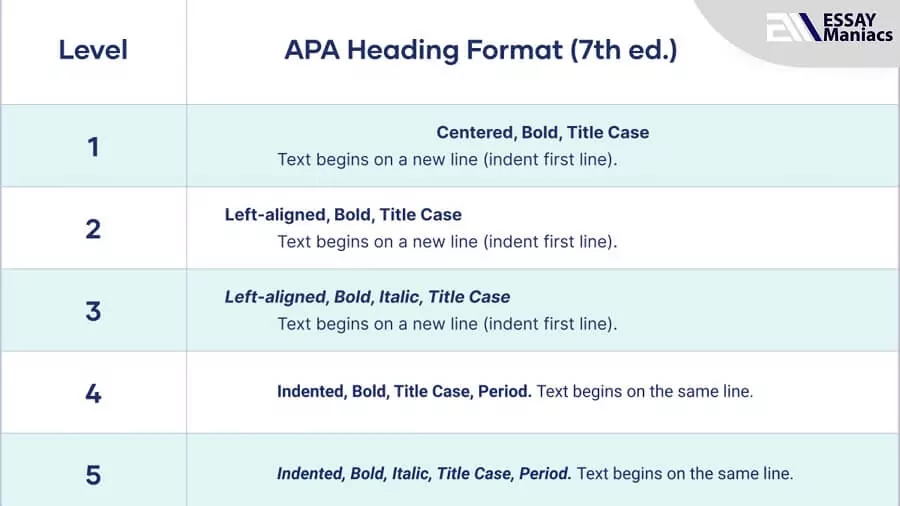
- Level 1 is bold, flush, or aligned with the left margin
- Level 2 is italicized, flush, or aligned with the left margin
- Level 3 is bold and center-aligned
- Level 4 is italicized and center-aligned
- Level 5 is underlined, flush, or aligned with the left margin
Ensure you use the correct subheading level to help you navigate through your essay or paper. It also helps to know what to be added to the automatic table of contents. Use the subheadings as illustrated below:
- Subheading 1 for the first subsection after the chapter title
- Subheading 2 for the subsections that are directly under Subheading 1
- Subheading 3 for the subsections that are directly under Subheading 2
- Subheading 4 for the subsections that are directly under Subheading 3
- Subheading 5 for the subsections that are directly under Subheading 4
Take some time and watch this video by Dr. Andy Jonson illustrates how to use headings and subheadings in academic writing.
Below are some sample questions, expert answers, and recommendations for essay subheadings and headings.
Should essays have subheadings?
Although shorter essays are written in continuous, flowing, and paragraphed texts and do not need subheadings, longer essays are carefully structured using headings and subheadings.
An essay or research paper can have headings and subheadings (subtopics) if it is long enough to accommodate different sections. Nevertheless, when writing the headings and subheadings, they should be relevant and consistent with the topic and contribute to the overarching goal of the essay or research paper (the thesis statement). A good length for a heading or subheading should be ten words or less. While standard essays do not use subheadings, they assuredly improve the structure of extended essays.
Subheadings subordinate the headings (the title of the essay). They should be persuasive, descriptive, and conversational. They should elaborate on what is in the headline and capture the importance of the topic. Maintain consistency when writing them.
Can introductions have subheadings?
For short papers, no. However, you can include sub-sections for longer papers with appropriate headings and subheadings. For instance, when writing a proposal, dissertation, or thesis, you can have sections and subsections for the problem statement, background information, research questions, hypothesis, aims/objectives, and paper overview.
Can a conclusion have a subheading?
You should not include subheadings in the concluding paragraphs of an essay unless for more extended research papers.
Can subheadings in essays be questions?
No, section headings and subheadings must not be phrased as questions in MLA, APA, or Harvard formatting styles.
Need a Discount to Order?
15% off first order, what you get from us.

Plagiarism-free papers
Our papers are 100% original and unique to pass online plagiarism checkers.

Well-researched academic papers
Even when we say essays for sale, they meet academic writing conventions.

24/7 online support
Hit us up on live chat or Messenger for continuous help with your essays.

Easy communication with writers
Order essays and begin communicating with your writer directly and anonymously.
How do I style headings and subheadings in a research paper?
Headings and subheadings can help organize and structure your writing. In general, longer and more complex works warrant more of them than shorter ones. Avoid overusing headings in short projects; they should never be used to compensate for poor structure or to explain an underdeveloped idea.
When headings are called for in your writing project, observe the basic guidelines below.
The paper or chapter title is the first level of heading, and it must be the most prominent.
Headings should be styled in descending order of prominence. After the first level, the other headings are subheadings—that is, they are subordinate. Font styling and size are used to signal prominence. In general, a boldface, larger font indicates prominence; a smaller font, italics, and lack of bold can be used to signal subordination. For readability, don’t go overboard: avoid using all capital letters for headings (in some cases, small capitals may be acceptable):
Heading Level 1
Heading Level 2
Heading Level 3
Note that word-processing software often has built-in heading styles.
Consistency
Consistency in the styling of headings and subheadings is key to signaling to readers the structure of a research project. That is, each level 1 heading should appear in the same style and size, as should each level 2 heading, and so on. Generally avoid numbers and letters to designate heads unless you are working in a discipline where doing so is conventional. Note that a heading labeled “1” requires a subsequent heading labeled “2,” and a heading labeled “a” requires a subsequent heading labeled “b.”
In a project that is not professionally designed and published, headings should be flush with the left margin, to avoid confusion with block quotations. (The exception is the paper or chapter title, which is centered in MLA style.)
For readability, it is helpful to include a line space above and below a heading, as shown in this post.
No internal heading level should have only one instance. For example, if you have one level 1 heading, you need to have a second level 1 heading. (The exceptions are the paper or chapter title and the headings for notes and the list of works cited.) You should also generally have text under each heading.
Capitalization
Capitalize headings like the titles of works, as explained in section 1.5 of the MLA Handbook .
The shorter, the better.

- Incorporating Headings & Subheadings
by acburton | May 18, 2024 | Resources for Students , Writing Resources
Think about the last time you read a really long academic article or publication for a class. When the text just seemed to drone on and on to no end, think back – weren’t you really grateful for those headings (and sometimes subheadings) that broke up the longer text, switched or elaborated on a topic, stimulated your eyesight, and gave your noggin a much needed break? I bet you were! Headings and subheadings enable longer texts and differing topics and subtopics to be clearly differentiated for your reader, yet linked in a way that can be clearly understood and appreciated. Let’s go through a few other benefits to using headings and subheadings in your writing!
Incorporating headings and subheadings into your longer pieces of writing;
- Enhances the readability of your work by organizing the content in your essay and guiding your reader.
- Delineates subsections of a topic and provides an avenue to expanding on more complex ideas within a main idea.
- Demonstrates your understanding of a particular citation style.
While headings and subheadings don’t replace the use of effective transitions , they can be used in tandem to further organize your paper, guiding your reader through your topic of choice. To use headings and subheadings appropriately, you’ll want to keep in mind three very important considerations:
- the hierarchy of a heading versus a subheading (and everything that may come after)
- the format (i.e., which citation style you are aiming to follow, and
- accessibility, to be sure that your paper is intelligible to all readers.
The Hierarchy
Headings and subheadings are represented in the form of a hierarchy, or a ranking that clearly characterizes your main topic from your subtopic or issue. The prefix “sub” in “subheading” means under or beneath so your subheading (or subissue) will always be placed underneath your heading. Use a heading whenever you are switching subjects and want to outline the main idea of a section and use subheadings to delineate the varying subsections underneath the main idea. Think of it like a pyramid structure, not in shape, but with your heading on the very top, subheading just beneath, and so on and so forth, going “deeper” into your research until you begin a new section.
Citation styles, including APA format, utilize a system of “Levels” to distinguish the format of headings and subheadings as they move throughout your essay. The number of headings to use in a paper depends on the length and complexity of the work (APAStyle).
In APA format, headings and subheadings are delineated into five possible levels: Level 1 is the highest or main level of heading, Level 2 is a subheading of Level 1, Level 3 is a subheading of Level 2, and so on through Levels 4 and 5 (APAStyle). Most students utilize Levels 1-3 for their work. If only one heading is needed for your assignment, use Level 1. If two levels are needed, use Levels 1 and 2 (and so on.) (APAStyle). The first image below provides a visualization of the APA heading format; the second image is an example of APA headings in a research paper from the field of education (APAStyle).

MLA in contrast emphasizes consistency over a specific style. Purdue Owl offers two examples of how to structure your essay using section headings and subheadings, although it is important to remember that while these can be used as a reference, they are by no means the rule . Remember, the goal is consistency throughout your paper.
Note: Although MLA does not have specific style for headings within your paper, there is a general format used for the first page of your paper. See Purdue Owl for more information.
Below, you can see two examples of acceptable headings for a paper that requires MLA formatting. The first follows a system of Levels, like what is used for APA format. The second example uses a format that numbers different sections and subsections. According to this example, Erosion and Terracing are examples of Soil Conservation, while Water Conservation and Energy Conservation require their own, main headings.

Accessibility
While the use of headings and subheadings work to enhance the readability of your work, without keeping accessibility in mind, your headings and subheadings can seem thorough and conducive to you, while being inaccessible and confusing to someone else. Check out these accessibility guidelines suggested by West Virginia University;
- Make sure your headings and subheadings always follow a consecutive hierarchy.
- Particularly when following APA format, do not skip a header for stylistic reasons.
- While using bold or italics may be unavoidable, do not use all caps. Doing so may cause some assistive technology to substitute full words for individual letters.
- Avoid using abbreviations.
- Aim to avoid language that can be confusing to non-native speakers of English (e.g., puns, a play on words).
Note: Visit the Writing Center for additional help on how to format with accessibility in mind!
Streefkerk, Raimo. “APA Headings and Subheadings | With Sample Paper.” Scribber, https://www.scribbr.com/apa-style/apa-headings/ . Accessed 18 May 2024.
Our Newest Resources!
- Best Practices for Emailing Instructors and Professors
- Revision vs. Proofreading
- Engaging With Sources Effectively
- The Dos and Don’ts of Using Tables and Figures in Your Writing
Additional Resources
- Black Lives Matter Writing Contest
- Graduate Writing Consultants
- Instructor Resources
- Student Resources
- Quick Guides and Handouts
- Self-Guided and Directed Learning Activities
- Comprehensive Guide to Headings and Subheadings in APA 7.0

Section 1: Introduction to Headings and Subheadings in APA 7.0-
In academic writing, the use of headings and subheadings is crucial for organizing and structuring a paper. APA (American Psychological Association) style, specifically in its 7th edition, provides clear guidelines on how to effectively use headings and subheadings to enhance readability and comprehensibility of research papers, essays, and other scholarly works. This section will provide a comprehensive introduction to the importance, purpose, and benefits of using headings and subheadings in APA 7.0 format.
Purpose of Headings and Subheadings
Headings and subheadings serve as visual cues to help readers navigate through the content of a paper. They create a hierarchical structure, indicating the relationships between different sections and subsections, and aid in organizing ideas and presenting information in a logical manner. By using headings and subheadings, writers can effectively divide their work into manageable and coherent sections, making it easier for readers to comprehend and follow the main arguments and supporting details.
Importance of Headings and Subheadings
Clear and well-structured headings and subheadings are essential in academic writing for several reasons. First and foremost, they enhance the overall readability of the paper by breaking down the text into smaller, digestible chunks. This organization allows readers to quickly identify and locate specific information, especially when they are scanning or skimming through the document.
Secondly, headings and subheadings contribute to the coherence and flow of the paper. By providing a clear roadmap, they guide the reader through the main ideas, supporting evidence, and key points presented in each section. This not only improves the overall structure of the paper but also helps maintain the logical progression of thoughts and arguments.
Additionally, headings and subheadings assist both readers and writers in comprehending complex topics. They enable writers to organize their thoughts, ensuring that each section focuses on a specific aspect or theme. This organization facilitates a deeper understanding of the subject matter for both the writer during the drafting process and the reader during the consumption of the paper.
Formatting Guidelines for Headings and Subheadings
APA 7.0 provides specific rules and formatting guidelines for using headings and subheadings. These guidelines include the use of different levels of headings, capitalization rules, and placement within the paper. Understanding and adhering to these guidelines is crucial for maintaining consistency and conformity with APA style.
The APA 7.0 formatting guidelines for headings and subheadings are based on a five-level hierarchy, with each level indicating the level of importance and hierarchy of information. Level 1 headings are the highest level, followed by Level 2, Level 3, and so on. Each level has a specific formatting style, such as font size, boldness, and indentation, to differentiate it from the other levels. Furthermore, APA 7.0 also provides guidance on the appropriate use of sentence case, title case, and capitalization in headings and subheadings. For instance, Level 1 headings are typically written in sentence case and are centered and bolded. Level 2 headings are aligned to the left margin, bolded, and written in title case. To maintain clarity and consistency, APA 7.0 also provides recommendations on the number of headings to use within a paper. It suggests that at least two headings should be used in any given section, as a single heading alone may not adequately represent the content covered.
Section 2: The Purpose and Importance of Headings and Subheadings in APA 7.0
Facilitating information retrieval.
One of the primary purposes of headings and subheadings in APA 7.0 is to facilitate information retrieval for readers. When faced with a lengthy document, readers often engage in scanning or skimming techniques to locate specific information or sections of interest. Well-structured headings and subheadings act as signposts, allowing readers to quickly identify the content they are seeking without having to read the entire text. By providing a clear and organized hierarchy, headings guide readers to the main sections of a paper, while subheadings further break down the content into more specific subsections. This hierarchical structure enables readers to navigate the document with ease, locating relevant information efficiently. Thus, headings and subheadings in APA 7.0 contribute significantly to the overall accessibility and user-friendliness of academic papers.
Enhancing Readability and Comprehensibility
Headings and subheadings play a vital role in enhancing the readability and comprehensibility of academic writing. They help break up large blocks of text into smaller, digestible sections, preventing the overwhelming feeling that dense paragraphs can create. By visually separating different sections and subsections, headings and subheadings allow readers to mentally prepare for the content they are about to encounter. Additionally, headings and subheadings improve the flow and coherence of a paper. They provide a roadmap for readers, helping them understand the organization and structure of the author's arguments and supporting evidence. Well-crafted headings and subheadings enable readers to follow the logical progression of ideas and maintain a clear understanding of the paper's main points. Finally, headings and subheadings aid in the comprehension of complex topics. By breaking down the content into smaller, focused sections, readers can grasp the material more easily. Headings act as cognitive cues, preparing readers for the information presented in each section. This approach not only facilitates understanding but also allows readers to engage with the content at a deeper level, promoting knowledge retention.
Organizing and Structuring Ideas
Headings and subheadings in APA 7.0 serve as valuable tools for organizing and structuring ideas within a paper. They help writers divide their work into meaningful sections, each addressing a specific aspect or theme related to the overall topic. This organization ensures that information is presented in a coherent and logical manner, making it easier for both the writer and the reader to navigate the paper.
By using headings and subheadings, writers can create a clear outline for their work, ensuring that each section has a distinct focus. This outline acts as a framework, guiding the writer in presenting their arguments and supporting evidence in a systematic and organized way. Writers can use headings to delineate major sections or main ideas, while subheadings allow for further subcategorization and exploration of subtopics.
Furthermore, headings and subheadings assist writers in structuring their thoughts during the writing process. By providing a visual representation of the paper's organization, headings help writers maintain a coherent flow of ideas and prevent the inclusion of irrelevant or tangential information. This structured approach not only improves the overall quality of the paper but also enhances the writer's ability to communicate their ideas effectively.
Conveying the Hierarchical Relationship of Information
Another important purpose of headings and subheadings in APA 7.0 is to convey the hierarchical relationship of information. By assigning different levels to headings, the writer can indicate the relative importance and order of ideas within the paper. Higher-level headings represent broader themes or major sections, while lower-level headings address more specific subtopics or subsections. This hierarchical structure helps readers understand the organization and logical flow of the paper at a glance. It allows them to grasp the overall structure and the relationships between different sections without having to read the entire document. Additionally, the use of indentation and formatting styles for each level of heading further reinforces the hierarchical relationship and aids in visual differentiation.
Section 3: Formatting Guidelines for Headings and Subheadings in APA 7.0
Proper formatting of headings and subheadings is crucial in APA 7.0 style to ensure consistency, clarity, and readability in academic writing. This section will delve into the specific formatting guidelines provided by APA 7.0 for headings and subheadings, including the use of different levels, capitalization rules, and placement within the paper.
Levels of Headings
APA 7.0 introduces a five-level hierarchy for headings, each denoting a different level of importance and significance within the paper. These levels provide a structured framework for organizing the content and help readers understand the organization and flow of ideas. Here are the five headings in APA 7.0:
Level 1: Centered, Bold and Title Case
Text begins here.
Level 2: Left-Aligned, Bold and Title Case
Level 3: Left-Aligned, Bold, Italics, and Title Case
Level 4: Left-Aligned, Bold, Title Case, and Period. Text begins here.
Level 5: Left-Aligned, Bold, Title Case, Italics, and Period . Text begins here.
Section 4: Organizing and Structuring Your Paper
Using headings and subheadings in apa 7.0.
Organizing and structuring your paper effectively is crucial for presenting your ideas in a logical and coherent manner. Headings and subheadings in APA 7.0 play a vital role in achieving this goal by providing a clear framework for organizing your content. This section will delve into strategies and best practices for utilizing headings and subheadings to organize and structure your paper in accordance with APA 7.0 guidelines.
Preparing an Outline
Before you begin writing your paper, it is helpful to create an outline that outlines the main sections and subsections you intend to cover. An outline acts as a roadmap, allowing you to visualize the overall structure and flow of your paper. It serves as a foundation for developing meaningful headings and subheadings that accurately represent the content and facilitate logical organization. Start by identifying the major sections that your paper will include, such as introduction, literature review, methods, results, discussion, and conclusion. These major sections will serve as Level 1 headings in APA 7.0. Next, break down each major section into subsections that address specific subtopics or aspects related to the main theme. These subsections will be represented by Level 2 headings. Depending on the complexity and depth of your paper, you may further divide the subsections into sub-subsections using Level 3, Level 4, and Level 5 headings. Creating a comprehensive outline not only helps you organize your thoughts but also ensures that you cover all the necessary components of your paper. It allows you to see the relationships between different sections and subsections, enabling you to present your arguments and evidence in a logical and coherent sequence.
Maintaining Consistency and Parallelism
Consistency is key when it comes to organizing and structuring your paper using headings and subheadings. It is important to establish a consistent framework that is followed throughout the entire document. Consistency ensures that readers can easily understand the hierarchy and relationships between different sections and subsections. When creating headings and subheadings, aim for parallelism in terms of grammatical structure and formatting. Parallelism means that headings at the same level should have a similar grammatical structure and formatting style. For instance, if you choose to use noun phrases for Level 2 headings, maintain this pattern consistently across all Level 2 headings in your paper. This helps readers navigate through the content smoothly and maintain a sense of coherence. Furthermore, parallelism extends to the use of punctuation and capitalization within headings and subheadings. Maintain consistent capitalization rules, such as sentence case for Level 1 headings and title case for Level 2 headings. This uniformity enhances the visual hierarchy and clarity of your paper.
Balancing Depth and Granularity
Effective organization and structuring involve finding the right balance between depth and granularity in your headings and subheadings. Level 1 headings represent major sections and should encapsulate broad themes or concepts, providing an overview of what will be discussed within each section. Level 2 headings, as subsections, delve into more specific topics or aspects related to the main theme of the major section.
Reviewing and Revising the Organization
Organizing and structuring your paper using headings and subheadings is not a one-time task. It is an iterative process that requires regular review and revision to ensure optimal clarity and coherence. Once you have completed the initial draft of your paper, review the organization of your headings and subheadings. Ask yourself if the structure effectively reflects the flow of your ideas and supports your main argument. Consider whether the headings accurately represent the content of each section and subsection. During the review process, pay attention to transitions between sections and subsections. Ensure that the headings and subheadings create a smooth transition from one topic to another, guiding readers through the logical progression of your paper. If you notice any gaps or inconsistencies, revise and refine the organization accordingly. Additionally, seek feedback from peers, mentors, or instructors. Their fresh perspective can provide valuable insights into the clarity and effectiveness of your headings and subheadings. Incorporate their feedback and make necessary adjustments to improve the overall organization and structure of your paper.
Section 5: Common Mistakes to Avoid in Using Headings and Subheadings in APA 7.0
While using headings and subheadings in APA 7.0 can greatly improve the organization and readability of your paper, it's important to be aware of common mistakes that can compromise the effectiveness of your headings. By understanding and avoiding these mistakes, you can ensure that your headings enhance the clarity and coherence of your academic writing. This section will explore some common mistakes to avoid when using headings and subheadings in APA 7.0.
Inconsistent Formatting
One of the most common mistakes is inconsistent formatting of headings and subheadings. In APA 7.0, it is crucial to maintain consistency in capitalization, alignment, and formatting styles across headings at the same level. Inconsistencies can confuse readers and disrupt the visual hierarchy of your paper. Ensure that all Level 1 headings have the same formatting, all Level 2 headings have the same formatting, and so on. Consistency in formatting contributes to the overall professionalism and readability of your work.
Poor Alignment and Spacing
Another mistake to avoid is incorrect alignment and spacing of headings and subheadings. In APA 7.0, Level 1 headings are centered and typically start on a new page or a new line with an extra line space before and after the heading. Level 2 headings and lower-level headings, however, are left-aligned and generally require an extra line space before the heading but not after. Failure to align and space headings correctly can create confusion and disrupt the logical flow of your paper. Review APA 7.0 guidelines carefully to ensure proper alignment and spacing of your headings.
Lack of Parallelism
Parallelism, or consistent grammatical structure, is crucial when using headings and subheadings. Headings at the same level should follow a similar structure to maintain coherence and readability. For example, if you use noun phrases for Level 2 headings, ensure that all Level 2 headings follow this pattern. Lack of parallelism can make your headings appear disjointed and may confuse readers. Consistently apply parallel structure within each level of headings to create a smooth and organized flow of information.
Overcomplicating the Heading Structure
While it is important to provide a clear and hierarchical structure to your paper, overcomplicating the heading structure can lead to confusion and excessive fragmentation. Strive to find a balance between providing enough detail to cover your content effectively and avoiding an excessive number of headings and subheadings. Each heading should represent a meaningful subdivision and contribute to the overall organization and coherence of your paper. Aim for a clear and concise heading structure that guides readers without overwhelming them with excessive levels or overly specific subdivisions.
Lack of Descriptiveness
Headings and subheadings should be descriptive and informative to accurately represent the content covered within each section. Avoid using generic or ambiguous headings that do not provide a clear indication of what readers can expect to find. Vague headings can leave readers uncertain about the content or make it challenging to locate specific information within your paper. Ensure that your headings succinctly capture the main ideas or themes of each section, guiding readers through your content effectively.
Ignoring the Reader's Perspective
When creating headings and subheadings, it's important to consider the perspective of your readers. Put yourself in their shoes and think about how your headings will facilitate their understanding and navigation through your paper. Consider whether your headings effectively communicate the main points, guide readers through the logical flow of your arguments, and enable them to locate specific information easily. Ignoring the reader's perspective can result in headings that are unclear, unhelpful, or inconsistent, hindering the overall readability and comprehension of your work.
Neglecting to Revise and Edit Headings
Headings should not be an afterthought or treated as static elements in your paper. Neglecting to revise and edit your headings can lead to inaccuracies, lack of clarity, or poor alignment with the final content of your paper. As you progress through the writing process, continuously review and refine your headings to ensure they accurately represent the content and flow of your arguments. Make necessary adjustments, reword headings for better clarity, and ensure that they align with the finalized structure and organization of your paper.
Recent Posts
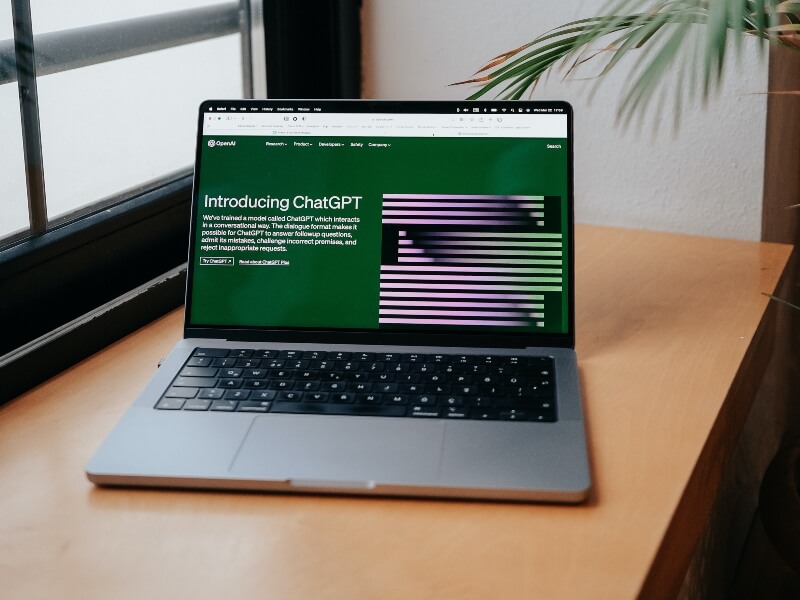
Common Reasons for Weak Sauce ChatGPT Prompts

Bar Graphs of Multiple Variables in Stata

Cox Proportional Hazards in Stata

Changing Title and Axis Labels in R’s GGplot Graphics
Have any questions?
Our support team is ready to answer your questions.
Help Center FAQ
To mark our first year, we've slashed all our prices in half. Order now to seize this limited opportunity!
Place Your Order

- ‹ Prev
- Next ›
1.5: Internal Headings and Subheadings
- Published: 2022
- Split-Screen
- Search Site
"Internal Headings and Subheadings", MLA Handbook
Download citation file:
- Ris (Zotero)
- Reference Manager
Headings and subheadings in the body of your research project can help organize and structure your writing, but you should avoid overusing them. Headings should never be used to compensate for poor structure or to explain an underdeveloped idea, and they are generally not needed in short, essay-length works. When headings are called for in your writing project, keep them short and observe the basic guidelines below.
Consistency in the styling of headings and subheadings is key to signaling to readers the structure of a research project. Word processing software often has built-in heading styles. Headings in the body of your research project should be styled in descending order of prominence. After the first level, the other headings are subheadings—that is, they are subordinate. Font styling and size are used to signal prominence. Each level 1 heading should appear in the same style and size, as should each level 2 heading, and so on. In general, a boldface, larger font indicates prominence; a smaller font, italics, or lack of bold can be used to signal subordination. For readability, avoid using all capital letters for headings (in some cases, small capitals may be acceptable).

No internal heading level should have only one instance. For example, if you use a level 1 heading, you should have at least one other level 1 heading. (The exceptions are the paper or chapter title and the headings for notes and the list of works cited.)
In the body of the paper, headings should be flush with the left margin, not indented or centered. For readability, include a line space above and below a heading.
Generally avoid using numbers and letters to designate headings unless you are working in a discipline where using them is conventional.
Capitalize and punctuate headings like the titles of works as explained in 2.90 – 2.119 .
When possible, make headings and subheadings parallel in structure—that is, ensure that headings at the same heading level match one another grammatically and share other basic similarities. When headings are parallel, readers can more easily grasp the structure and content of a research project as a whole.
First, check that headings are of the same grammatical category. In the list, consider revising the heading “Can Online Sources Be Plagiarized?” so that it is parallel with the other headings. Check also for number agreement. If headings use a mix of singular and plural nouns, try to adjust them so that they are all singular or all plural.
Original . Revised . Understanding Digital Literacy Understanding Digital Literacy Learning about Online Research Learning about Online Research Exploring Primary and Secondary Sources Exploring Primary and Secondary Sources Can Online Sources Be Plagiarized? Avoiding Plagiarism View Large
If you have a mix of headings with and without subtitles, consider editing them so that all headings at the same level either contain a subtitle or do not. In the following list, you could omit the subtitle from “Learning about Online Research: Broad and Narrow Searches” to make the headings parallel.
Original . Revised . Understanding Digital Literacy Understanding Digital Literacy Learning about Online Research: Broad and Narrow Searches Learning about Online Research Exploring Primary and Secondary Sources Exploring Primary and Secondary Sources Avoiding Plagiarism Avoiding Plagiarism View Large
Check your headings for consistent length—you may quickly identify any outliers. Below, the first heading is much longer than the others, so you might forgo the quotation, shorten the subtitle, or both.
Original . Revised . “Empowered to Make Critical Decisions”: Understanding Digital Literacy and Stopping the Circulation of Disinformation and Misinformation Understanding Digital Literacy Learning about Online Research Learning about Online Research Exploring Primary and Secondary Sources Exploring Primary and Secondary Sources Avoiding Plagiarism Avoiding Plagiarism View Large
Book Contents


Stay in the Loop!
Sign up now, so you don’t miss out on important announcements regarding future demos, webinars, and more.
Quick Links
- MLA Handbook
- Administering Your Institutional Account
- Accessibility
- Terms of Use
- Promote Your Access to MLA Handbook Plus
- 85 Broad Street New York, NY 10004 646 576-5000
- Contact Information
- © Copyright 2021 MLA
This Feature Is Available To Subscribers Only
Sign In or Create an Account
A clear, arguable thesis will tell your readers where you are going to end up, but it can also help you figure out how to get them there. Put your thesis at the top of a blank page and then make a list of the points you will need to make to argue that thesis effectively.
For example, consider this example from the thesis handout : While Sandel argues persuasively that our instinct to “remake”(54) ourselves into something ever more perfect is a problem, his belief that we can always draw a line between what is medically necessary and what makes us simply “better than well”(51) is less convincing.
To argue this thesis, the author needs to do the following:
- Show what is persuasive about Sandel’s claims about the problems with striving for perfection.
- Show what is not convincing about Sandel’s claim that we can clearly distinguish between medically necessary enhancements and other enhancements.
Once you have broken down your thesis into main claims, you can then think about what sub-claims you will need to make in order to support each of those main claims. That step might look like this:
- Evidence that Sandel provides to support this claim
- Discussion of why this evidence is convincing even in light of potential counterarguments
- Discussion of cases when medically necessary enhancement and non-medical enhancement cannot be easily distinguished
- Analysis of what those cases mean for Sandel’s argument
- Consideration of counterarguments (what Sandel might say in response to this section of your argument)
Each argument you will make in an essay will be different, but this strategy will often be a useful first step in figuring out the path of your argument.
Strategy #2: Use subheadings, even if you remove them later
Scientific papers generally include standard subheadings to delineate different sections of the paper, including “introduction,” “methods,” and “discussion.” Even when you are not required to use subheadings, it can be helpful to put them into an early draft to help you see what you’ve written and to begin to think about how your ideas fit together. You can do this by typing subheadings above the sections of your draft.
If you’re having trouble figuring out how your ideas fit together, try beginning with informal subheadings like these:
- Introduction
- Explain the author’s main point
- Show why this main point doesn’t hold up when we consider this other example
- Explain the implications of what I’ve shown for our understanding of the author
- Show how that changes our understanding of the topic
For longer papers, you may decide to include subheadings to guide your reader through your argument. In those cases, you would need to revise your informal subheadings to be more useful for your readers. For example, if you have initially written in something like “explain the author’s main point,” your final subheading might be something like “Sandel’s main argument” or “Sandel’s opposition to genetic enhancement.” In other cases, once you have the key pieces of your argument in place, you will be able to remove the subheadings.
Strategy #3: Create a reverse outline from your draft
While you may have learned to outline a paper before writing a draft, this step is often difficult because our ideas develop as we write. In some cases, it can be more helpful to write a draft in which you get all of your ideas out and then do a “reverse outline” of what you’ve already written. This doesn’t have to be formal; you can just make a list of the point in each paragraph of your draft and then ask these questions:
- Are those points in an order that makes sense to you?
- Are there gaps in your argument?
- Do the topic sentences of the paragraphs clearly state these main points?
- Do you have more than one paragraph that focuses on the same point? If so, do you need both paragraphs?
- Do you have some paragraphs that include too many points? If so, would it make more sense to split them up?
- Do you make points near the end of the draft that would be more effective earlier in your paper?
- Are there points missing from this draft?
- picture_as_pdf Tips for Organizing Your Essay
- Pangram Solver
- Anagram Solver
- Rhyming Dictionary
- AI Title Generator
- Poem Title Generator
- Book Title Generator
- YouTube Title Generator
- Essay Title Generator
- Title Rewriter
- Title Capitalization
- Sentence & Paragraph Rewriter
- Essay Writer
- Book Title Wizard
- Random Movie Generator
- Fortune Cookie Generator
- Random European Country Generator
- Random Country Generator
- Empty and Invisible Character Generator – Blank ( ) Texts
- Random State Generator
- Prompts Generator
- Text Repeater (Add Text, Repeat, & Share)
- Speech Generator
- Character Name Generator
- Name Generators
- Pokemon Name Generator
- Character Backstory Generator
- Song Generator
- Poem Generator
- Word Search Puzzles
- Ideation Articles
- Random Topic Generator
- Writing Prompt Generator
- Random Essay Title Generator
- Writing Articles
- Online Word Counter
- Online Grammar Checker
- Headline Analyzer
- Best Book Writing Software and Book Writing Apps
- 150 Best Resources for Writers
- Productivity
- English Language
- Grammar Tips
- Headline Analyzer Tool
- Title Capitalization Rules
- For WordPress
- Publishing Articles
- Email Marketing
- Book Articles
- How to Get A Book Published
- Best Literary Agencies
- How To Self Publish a Book
7th Edition APA Style: How to Use APA Headings in Your Paper
APA headings and subheadings give your paper the structure it needs to differentiate and separate sections – much like how we’ve structured this article. Sounds simple, right? Not exactly.
Like a reference list, in-text citations, footnotes, and abstract, APA headings require correct formatting. More so since the American Psychological Association (APA) released the 7th edition of their style guide.
In this article, we’ll go through the different APA heading levels and their formats. You will also have access to APA headings examples and insight on APA capitalization rules so you can nail APA heading formatting without breaking a sweat.
What Are APA Headers?
As mentioned earlier, APA headers separate and differentiate your paper’s sections. They are crucial in scholarly works because:
- They give structure to your report.
- Readers and your adviser or restructure can quickly identify the sections of your paper.
- When properly formatted and used, they can provide a visual aid to improve the flow of information in your paper.
The APA headers are divided into five levels (more on this later!).
APA 6th Edition vs. 7th Edition: Is There A Difference In Headings?
Before diving down to APA’s unique headings system, let’s talk about the elephant in the room – the style guide edition. And, we hate to break it to you. There are a lot of changes between the APA 6th edition vs. 7th edition, but since we’re only talking about headings, we’re not going to outline all the differences.
Luckily for you, there are not a lot of changes in the APA style 7th edition headings.
- For the capitalization and style, you should write the headings in title case and boldface.
- Formatting of the first level (main level of heading) and second level headings are almost identical to the 6th edition, except for the new title case and boldface rules.
- The third, fourth, and fifth-level headings of the 7th edition APA are distinguished by using periods, indentation, and italics.
To better understand these changes, you can refer to the table below.

In addition to these formatting changes, the 7th APA style guide also dictates that student papers do not need a running head.
What Are the Different APA Heading Levels?
Now that you know what APA headings are and the difference between the headings of APA 6th and 7th editions, let’s talk about the levels.
APA headings levels are divided into five – Level 1, Level 2, Level 3, Level 4, and Level 5. In a hurry? You can check the comparison table below.
| 1 | Centered | Yes | None | Begins as new paragraph |
| 2 | Flush left | Yes | None | Begins as new paragraph |
| 3 | Flush left | Yes | None | Begins as new paragraph |
| 4 | Indented | Yes | Yes | Same line as regular paragraph |
| 5 | Indented | Yes | Yes | Same line as regular paragraph |
Expert Insight: Title case means capitalizing the first letter of words with at least four or more letters. These words are typically proper nouns, pronouns, adverbs, nouns, and adjectives. However, keep in mind that the first word in a header is always in upper case, even if the first word is an article like “ the” or “a.”
Level 1
Level 1, or the first level of heading, represents the main section of your paper. For instance, if your paper topic discusses the effects of social media platforms on university students, the header “Method” should be in level 1.
In a 7th APA style, the structure should be:
The text after Level 1 will be a new paragraph and not on the same line as the heading.
Expert Insight: Does the Level 1 format look familiar? That’s because it has the same structure as the Paper Title element (APA 7 title page) in the APA cover page format.
What if the next portion of your paper discusses the sampling method you’ve used? In that case, the first level of subsection should be the second level of headings or simply Level 2. Why? This is because the “sampling method” is a cluster of the main level “Method.”
The structure of a Level 2 header is, however, different. Instead of having the “Sampling Method” centered, you’ll flush it to the left. A Level 2 header will be in bold, and the paragraph will start in a new line.
Here’s how a Level 2 APA is formatted:
Tip: When in doubt, remember that APA sub-headings or subsections should be related to the subsequent header.
Level 3
The third level of headings, or Level 3, further expounds the information you’ve shared in Level 2 or “Sampling Method.” In this case, your level 3 will be “Procedure.”The formatting of Level 2 and Level 3 are pretty similar.
As a matter of fact, there is one key difference a Level 3 header will be in bold italic. The alignment, boldface, and title case will remain the same.
You should format a Level 3 APA header like this:
Level 4
You will need to use the fourth level of headings or Level 4 if there are other details from the Level 3 “Sampling Method” that you need to discuss further. In our APA example, that Level 4 will be the “Participant Recruitment.”
The format of Level 4 is distinct from levels 1, 2, and 3 because:
- It is indented.
- The paragraph is in line with the heading.
- You will add a period at the end of the heading.
To better understand an APA Level 4 heading format, here is an example:
You’ve probably caught on that Level 5 is a subheading of Level 4, and you are correct! If “Participant Recruitment” warrants more information, you can use the fifth level of headings for either “Tools” or “Compensation.”
The formatting of Level 5 is a bit similar to Level 4; the only difference is that you’ll use a boldface italic. Other elements like indent and period will remain the same.
APA Heading Examples
If you combine the levels, your paper should look like this:

How to Choose the Right APA Heading to Use?
With five levels to choose from, selecting which one you should use for your paper can be daunting. Here are some tips:
- Use the Level 1 APA header when it is an important part of the paper. For instance, method, conclusion, and results.
- Use the Level 2 heading when the subsections are related to the first level.
- You should apply a Level 3 header when the APA subheadings are related to Level 2.
- Level 4 headers should be used in your paper if the sections are directly correlated with Level 3.
- Lastly, you should use Level 5 headers when the information is related to Level 4.
How Do You Organize Headings in APA 7?
Now that you are familiar with all the five-level headings in APA 7. The question now is, how do you arrange them? The rule of thumb for organizing APA 7 headers is to always start with Level 1, followed by subsequent headings of equal importance.
Does that mean that the levels should only be used once? Not technically. You can have all the number of levels in a section as long as you follow the progression, wherein Level 1 always comes first.
Tip: Don’t mistake section labels and APA headings or vice versa. Section labels or special headings are different from regular headings. Not only are they formatted differently, but they also appear at the top section of the paper, below the pagination or page number. You will always find them at the start of a new page.
Additional APA 7 Header Guidelines
On top of the format or structure of the level headers, you should also watch out for the following:
- Text, including the headers, should be double-spaced.
- Font size and typeface should stay consistent throughout your article. For instance, if you’ve used Times New Roman 12pt in your headers, the text should also have the same typeface and size.
- Depending on your teacher’s requirements, you may or may not need labels (letter or number) for the headers. When in doubt, ask for clarification.
- There should be at least two APA subheadings in your paper. If you only have one, consider adding more sections in your paper or use no subheadings at all.
APA Headings FAQ
How to create table of contents in apa format.
In APA 7th edition, it is not required to have a table of contents, but in case your adviser requires one, you can easily do so whether you are using Google docs or Microsoft Word.
In Google Docs:
- Set the headers in the correct header size. Click the “Normal Text” dropdown and choose Header 1 for Level 1 APA headings, Header 2 for Level 2, and so on.
- Go to Insert>Table of Contents.
Note: Keep in mind that APA 7th style guide dictates that the headings and text should have the same font size and typeface. So, after printing the table of contents, make sure to revert the levels to the correct size.
In Microsoft Word:
- Highlight the level heading
- Select Update the Heading
- Match the heading size with the level heading. For instance, if you have a Level 1 Header, select Header 1.
- Go to References > Table of Contents > Custom Table of Contents.
- Input how many headings you will need.
Tip: Ensure you set the levels in the correct format before creating the table of contents. All levels no longer have a lower case heading. The only thing you should watch out for is the alignment, boldface, italics, and period.
Do You Have to Use All the APA Headers?
No, you don’t have to use all five APA headers in your paper. The headers and the number of subsections will highly depend on your writing style and subject matter.
Is There an Introduction Heading?
No, there isn’t an “introduction heading.” This is because the first paragraphs of a paper are already understood as the introduction section.
Heading in the Right Direction
The format of APA headings and subheadings can be confusing at first. But remember, APA capitalization rules for the 7th APA edition mean using title case for all heading levels; no more uppercase and lowercase headings. And you can distinguish the third, fourth, and fifth-level headings through italicization, period, and indentation. As for the text after the heading, only levels 4 and 5 will have the paragraph in line with the headings.
Don’t forget that running headers are no longer required in student papers! But just to be on the safe side, make sure to always ask your instructor.
RELATED ARTICLES MORE FROM AUTHOR

Is “Your” Capitalized in a Title?

Is “A” Capitalized in a Title?

Is “About” Capitalized in a Title?

Is “And” Capitalized in a Title?

Is “That” Capitalized in a Title?

Is “Our” Capitalized in a Title?
Leave a reply cancel reply.
Save my name, email, and website in this browser for the next time I comment.
- Accessibility
Forgot your password?
Lost your password? Please enter your email address. You will receive mail with link to set new password.
Back to login
Still have questions? Leave a comment
Add Comment

Checklist: Dissertation Proposal
Enter your email id to get the downloadable right in your inbox!

Examples: Edited Papers
Need editing and proofreading services, apa headings & subheadings | formatting guidelines & examples.
- Tags: APA , APA Style , Formatting Guidelines
APA headings and subheadings provide a clear structure to your document and make it easy to navigate through. This is especially beneficial when it comes to longer documents.
The APA format makes use of headings and subheadings to indicate a hierarchy. But what is an APA paper heading and how do you customize it? We will answer all these questions with the help of concrete examples and templates.
Let’s start off with understanding the basics of how to customize these APA format headings and subheadings.
APA heading format
There are five APA heading levels that can be used as per the latest APA guidelines. You can decide which level of heading to use, depending on the length and complexity of your document.
- The level 1 heading is the main APA heading for your paper, which is used to indicate all the major sections (excluding the introduction).
- The level 2 heading is included under the level 1 heading and is used to indicate its different aspects.
- The level 3 heading is used to indicate the subpoints to be included under the level 2 heading and so on.
Here are the formatting guidelines for the APA heading formats for the 7th edition:
- Avoid creating too many subheadings. This makes your document shabby and difficult to understand.
- Do NOT number the APA-style headings and subheadings. The APA paper format does not make use of Roman and Arabic letters and numerals to number the headings.
- Include a double space between the content and the heading for the first 3 levels.
- Use the title case for all your headings.
- Avoid creating a single APA subheading under the parent heading.
Let’s take a look at how to format each of these APA heading levels in more detail.
APA heading levels
As stated above, the APA Style guide consists of 5 levels of headings. Each level heading should be bolded and in some cases italicized . Here are the guidelines for the five APA format headings:
APA level 1 heading
The level 1 heading for an APA paper is the main heading in an APA-style paper. It is used for all the significant sections of the paper such as “Methods”, “Results”, and “Discussion”.
Do NOT include the Introduction in the level 1 heading. The heading of your paper present in the APA title page serves as a de facto heading for your introduction.
Here are the formatting guidelines for an APA level 1 heading:
- Centrally align and bold the heading.
- Leave a double space between the heading and the text under it.
- Begin writing the text on a new line, leaving an indent 0.5 inches from the left margin.
Here is the APA heading format example:
APA Level 1 Heading
The text is indented and begins on a new line.
A section label is used to indicate specific parts of your paper including. It is similar to a level 1 heading but is formatted slightly differently. It is bolded and centrally aligned but is placed in a separate line at the top of a new page.
APA level 2 heading
A level 2 heading is a subsection that is included under the level 1 heading. For instance, subheadings such as “Test Sample” are included under the main heading “Method”. Make sure that there are two or more subheadings present under each main heading.
The level 2 APA subheading format is as follows:
- Left align and bold the heading.
- Leave a double space between your heading and the text pertaining to it.
- Leave an indent and begin writing the text on a new line.
Here is a level 2 APA heading example:
APA Level 2 Heading
APA level 3 heading
Level 3 APA subheadings are used to further categorize characteristics included under the level 2 subheading. For instance, the level 2 subheading “Test Sample” may further be divided into sample groups such as “Preteens”, “Adolescents”, and “Adults” .
Here are the formatting guidelines for an APA level 3 heading:
- Left align, bold, and italicize the heading.
- Leave space between the heading and the text included below it.
- Leave a 0.5-inch indent and begin writing the text on a new line.
Here is a level 3 APA heading example:
APA Level 3 Heading
APA level 4 heading
The level 4 APA subheadings are rarely used when it comes to school papers. They’re more often used in more complex and detailed papers such as postgraduate or professional research papers. It is used to further categorize information included in the level 3 heading. For instance, the sample group of “Preteens” can further be divided into categories such as “Children (6–8 years)” and “Children (9–12 years)”.
Following are the formatting guidelines for an APA level 4 heading:
- Left align, indent, and bold the heading.
- End the heading with a period.
- Begin writing the text after the period in the same line.
Here is a level 4 APA heading example:
APA Level 4 Heading. The text begins in the same line.
APA level 5 heading.
The level 5 heading is the final heading included under the APA formatting guidelines. It is used to further categorize information included under the level 4 heading. For instance, the category “Children (6–8 years)” can be further divided into “Boys” and “Girls”.
Following are the formatting guidelines for an APA level 5 heading:
- Left align, indent, bold, and italicize the heading.
- End your heading with a period.
Here is a level 5 APA heading example:
APA Level 5 Heading. The text begins in the same line.
When you put all of the headings together, it should look something like this:
APA Level 5 Heading . The text begins in the same line.
APA heading format for Microsoft Word and Google Docs
Things get much easier when it comes to formatting APA headings in MS Word and Google Docs. Instead of individually inserting each heading, you can simply make use of the “styles” feature. This allows you to select a heading of your choice with a single click.
Make sure to edit your heading as per the APA formatting guidelines, since these default settings are not available in MS Word or Google Docs.
APA heading example
To understand how the APA levels are structured, let’s take a look at an APA format for headings. The following research paper outline highlights the methods used to collect the effect of coffee on preteens and young adults.
Here’s how the headings and text should be structured in the following example.
If you think formatting is not your strong suit and you want to make things easier, consider working with professional editing services . These professionals not only correct structural errors and content flow but also rectify all proofreading errors.
Need help with formatting your paper? Here are a few more articles you can refer to:
- MLA Format: 9th Edition Paper Formatting Guidelines
- APA Header Format: 5 Steps & Running Head Examples
- Chicago Style Citation: Quick Guide & Examples
- Chicago Title, Cover Page & Body | Paper Format Guidelines
- How to Create In-Text Citations and Reference Page in APA 7
Frequently Asked Questions
When should i use each level of heading, how are headings numbered in apa style, can i use more than five levels of headings in apa style.
Found this article helpful?
Leave a Comment: Cancel reply
Your email address will not be published.
Your vs. You’re: When to Use Your and You’re
Your organization needs a technical editor: here’s why, your guide to the best ebook readers in 2024, writing for the web: 7 expert tips for web content writing.
Subscribe to our Newsletter
Get carefully curated resources about writing, editing, and publishing in the comfort of your inbox.
How to Copyright Your Book?
If you’ve thought about copyrighting your book, you’re on the right path.
© 2024 All rights reserved
- Terms of service
- Privacy policy
- Self Publishing Guide
- Pre-Publishing Steps
- Fiction Writing Tips
- Traditional Publishing
- Additional Resources
- Dissertation Writing Guide
- Essay Writing Guide
- Academic Writing and Publishing
- Citation and Referencing
- Partner with us
- Annual report
- Website content
- Marketing material
- Job Applicant
- Cover letter
- Resource Center
- Case studies
Formatting APA Headings and Subheadings
- Writing Essays
- Writing Research Papers
- English Grammar
- M.Ed., Education Administration, University of Georgia
- B.A., History, Armstrong State University
In American Psychological Association style, APA headings and subheadings are used to give readers a general idea of the content and what to expect from a paper , and it leads the flow of discussion by dividing up a paper and defining each section of the content.
APA style is different than Modern Language Association style , which is used in most humanities courses, and Chicago style , which is used in most history courses. There are some differences between APA, MLA, and Chicago style headings in papers, particularly on the title page as well as at the top of subsequent pages.
Fast Facts: APA Headers
- APA style is generally used for social science research papers.
- There are five heading levels in APA. The 6th edition of the APA manual revises and simplifies previous heading guidelines
APA uses something called a "running head," while the other two styles do not. MLA uses a left-indented topper for the paper author's name, the professor's name, the course name, and date, while MLA and Chicago style do not. So it's important to use the correct style for APA headings when formatting a paper in APA style. APA style uses five levels of headings.
APA Level Headings
APA style recommends using a five-level heading structure based on the level of subordination. Purdue OWL notes the APA headings levels as follows:
| APA Headings | |
|---|---|
| Level | Format |
| 1. | Centered, Boldface, Uppercase, and Lowercase Headings |
| 2. | Left-aligned, Boldface, Uppercse, and Lowercse Heading |
| 3. | Indented, boldface, lowercase heading with a period. |
| 4. | |
| 5. | Indented, italicized, lowercase heading with a period. |
The sections named above are considered major elements of your paper, so these sections should be treated as the highest level of headings. Major levels (highest level) titles in your APA title are centered on your paper. They should be formatted in boldface and the important words of the heading should be capitalized .
In addition to the above rules, headings and subheadings also should not be accompanied by letters or numbers. You should use as many levels as required in your paper to present the most organized structure. Not all five levels should be used, but the same level of heading or subheading should be of equal importance regardless of the number of subsections under it.
For level one and two headings, paragraphs should begin under the heading on a new line, and these levels should capitalize each word in the heading. However, levels three through five should have the paragraph begin in line with the headings, and only the first word is capitalized. In addition, in levels 3-5, the headings are indented and end with a period.
Example APA-Formatted Paper
The following shows, in part, what an APA-formatted paper would look like. Where needed, explanations have been added to indicate the placement or formatting of the headers:
RESEARCH PROPOSAL (Running head, all caps and flush left)
(The below title page information should be centered and at the center of the page)
Research Proposal
Professor XXX
April. 16, 2019
XXX University
RESEARCH PROPOSAL (Each page should start with this running head, flush left)
Abstract (centered)
Research shows that developmentally disabled individuals need skills training in order to be able to function independently as adults (Flannery, Yovanoff, Benz & Kato (2008), Sitlington, Frank & Carson (1993), Smith (1992). There is a need for further research detailing what kinds of services are important to success, such as reinforcement of domestic, vocational and social skills, as well as financial planning . This paper proposes to answer the question: What is the effect of services provided by Regional Centers on the independent living skills of developmentally disabled adults?
Operational Definition of Variables.
The Independent Variable would be services provided by Regional Centers. The dependent variable would be independent living skills of developmentally disabled adults. I will test my hypothesis – that such services could lead to greater independence in developmentally disabled adults – by examining living skills of a group of developmentally disabled adults with services provided by Regional Centers to a group of developmentally disabled adults who do not receive Regional Center services. I will establish this “control” group by examining a similar group of individuals who have sought – but refused – Regional Center services.
Benefits of the research
An abundance of literature reveals a great need for better transitional services for developmentally delayed individuals leaving high school and entering adulthood (Nuehring & Sitlington, 2003, Sitlington, et. al., 1993, Beresford, 2004). Many of the studies focus on transitional services needed to aid developmentally disabled adults move successfully from high school to the adult working world (Nuehring & Sitlington, 2003, Sitlington, et. al., 1993, Flannery, et. al., 2008). Yet, some of those same researchers note that most developmentally disabled adults do not work after high school (Sitlington, et. al.,
RESEARCH PROPOSAL
1993). More recently (and even in older studies), researchers have begun to note that developmentally delayed adults need services to help them succeed in adulthood in a variety of areas needed for successful independent living, such as living arrangements, financial and budgeting skills, relationships, sex, aging parents, grocery shopping and a host of other issues (Beresford, 2004, Dunlap, 1976, Smith, 1992, Parker, 2000). Few agencies exist nationally to provide such services to developmentally delayed individuals from birth through adulthood. However, in California, a group of 21 Regional Centers provides services to developmentally delayed adults ranging from life-planning, funding of services and equipment, advocacy, family support, counseling, vocational training, etc. (What are regional Centers? n.d.). The purpose of this study, then, is to determine the effects of Regional Center services on the independent living skills of disabled adults.
Literature Analysis (centered)
Smith (1992) notes that many developmentally disabled adults fall “through the cracks” once they reach adulthood. Smith used a survey method to examine the success or lack thereof of 353 developmentally disabled adults. Smith noted that 42.5% were employed full time, 30.1% were employed part time and 24.6% were unemployed. In discussing results, Smith noted that what was needed to improve the employment situation of these individuals was to ensure that they learn how to access Vocational Rehabilitation services and that those providing services –vocational rehabilitation counselors, teachers, and other professionals -- be better trained in reaching out to such individuals. In other
words, if developmentally delayed adults simply had better access to vocational rehabilitation services (the independent variable), they would somehow become more successful in terms of full-time employment. Smith provides no empirical evidence to demonstrate how or why this would occur.
Synthesis of Literature Relevant to the Research Proposition
Sitlington, et. al. (1993) imply that if developmentally delayed individuals are not successful in adulthood, it is, essentially, their fault. Sitlington, et. al. give no indication that providing vocational services alone may not be enough. And, there is nothing in Sitlington, etc....
Title Page, Abstract, and Introduction
The title page is considered the first page of an APA paper. The second page will be the page containing an abstract. Because the abstract is a main section, the heading should be set in boldface and centered on your paper. Remember that the first line of an abstract is not indented. Because the abstract is a summary and should be limited to a single paragraph, it should not contain any subsections.
Every paper begins with an introduction, but according to APA style, an introduction should never carry a heading that labels it as such. APA style assumes that the content that comes at the beginning is an introduction and therefore doesn't require a heading.
As always, you should check with your instructor to determine how many main (level-one) sections will be required, as well as how many pages and sources your paper should contain.
- APA In-Text Citations
- Writing a History Book Review
- Social Studies Research Project Topics
- Write a Compare and Contrast Essay
- Understanding Point of View in Literature
- What Is Expository Writing?
- An Essay Revision Checklist
- Examples of Great Introductory Paragraphs
- How to Outline and Organize an Essay
- Tips on How to Write an Argumentative Essay
- 12 Interesting Ethical Topics for Essay Papers
- Topical Organization Essay
- Study for an Essay Test
- How to Write a Great Book Report
- How to Start an Essay: 13 Engaging Strategies
- How to Write a Response Paper
Encyclopedia for Writers
Writing with ai, apa headings and subheadings.
- © 2023 by Jennifer Janechek - University of Iowa
- headings when there are at least two subsections within a larger section.
- using subheadings only when the paper has at least two subsections within a larger section
Table of Contents
APA headings and subheadings refers to the rules for formatting sections of documents in the 7th Edition of the American Psychological Association’s Publication Manual .
A research paper written in APA style should be organized into sections and subsections using the five levels of APA headings.
Related Concepts:
Notice how sections contain at least two smaller subsections in the example below:
Design
Participants. , demographics..
Characteristics.
Limitations
Starting with the first level of heading, the subsections of the paper should progressively use the next level(s) of heading without skipping any levels. Major sections of the paper’s main body, including the Method, Results, and Discussion sections, should always be formatted with the first level of heading. However, keep in mind that the Introduction section, which is preceded by the full title of the paper, should be presented in plain type. Any subsections that fall under the major sections are formatted with the next level of heading.
Note that all paragraphs of the main body, including those that fall under subsections of a larger section, still maintain the pattern of indentation, use Times New Roman font, 12 pt., and are double-spaced. There are no extra lines or spaces between paragraphs and headings.
How are the five levels of APA-style headings formatted?
Format each of the five levels of APA-style headings as demonstrated in the example below. Note that while the example features headings titled “First Level,” “Second Level,” and so on, each heading in your paper should be named according to the section it describes.
First level
The first level of heading is bolded and centered, and the first letter of each word in the heading is capitalized. The paragraph text should be typed on the following line and indented five spaces from the left.
Second level
The second level of heading is bolded and situated flush left, and the first letter of each word in the heading is capitalized. The paragraph text should be typed on the following line and indented five spaces from the left.
Third level
The third level of heading is bolded, indented five spaces from the left, and followed by a period. Capitalize only the first letter of the first word in the heading and of proper nouns. The first paragraph following this heading should be typed on the same line as the heading.
Fourth level
The fourth level of heading is bolded, italicized, indented five spaces from the left, and followed by a period. Capitalize only the first letter of the first word in the heading and of proper nouns. The first paragraph following this heading should be typed on the same line as the heading.
Fifth level
The fifth level of heading is italicized, indented five spaces from the left, and followed by a period. Capitalize only the first letter of the first word in the heading and of proper nouns. The first paragraph following this heading should be typed on the same line as the heading.
Method (1st level)
Design (2nd level)
Participants (3rd level)
Demographics. (4th level)
Age Group. (5th level)
Limitations (2nd level)
- For student papers, include only the page number in the top right margin of every page of the paper
- For professional papers, place the page number in the top right margin and the running head in the top left margin of every page of the paper. Running heads should be a shortened version of the paper title.
The Elements of Style
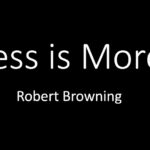
Brevity - Say More with Less

Clarity (in Speech and Writing)

Coherence - How to Achieve Coherence in Writing

Flow - How to Create Flow in Writing

Inclusivity - Inclusive Language

The Elements of Style - The DNA of Powerful Writing

Recommended

Academic Writing – How to Write for the Academic Community

Structured Revision – How to Revise Your Work

Professional Writing – How to Write for the Professional World

Authority & Credibility – How to Be Credible & Authoritative in Research, Speech & Writing

Citation Guide – Learn How to Cite Sources in Academic and Professional Writing
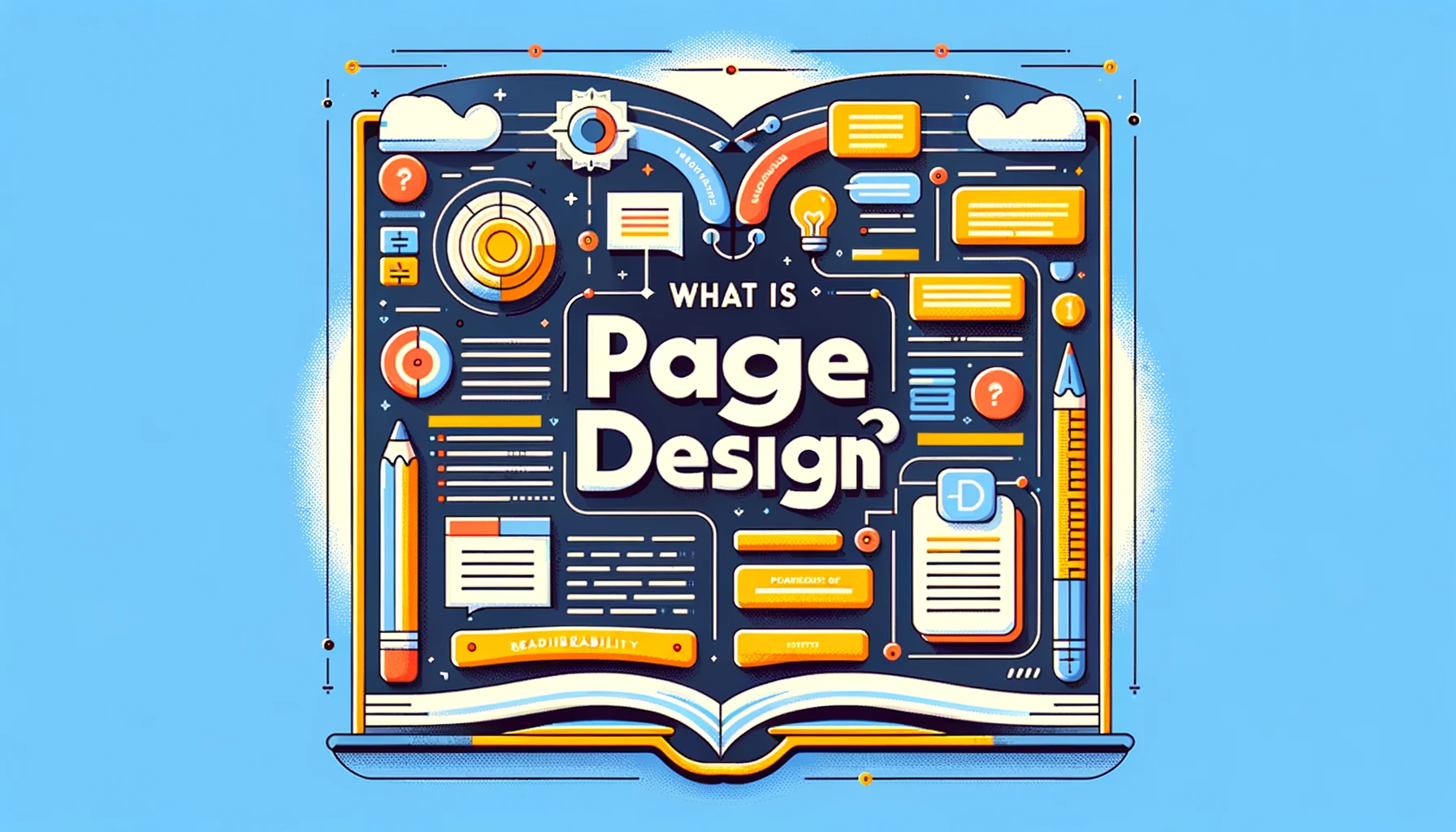
Page Design – How to Design Messages for Maximum Impact
Suggested edits.
- Please select the purpose of your message. * - Corrections, Typos, or Edits Technical Support/Problems using the site Advertising with Writing Commons Copyright Issues I am contacting you about something else
- Your full name
- Your email address *
- Page URL needing edits *
- Name This field is for validation purposes and should be left unchanged.
Other Topics:
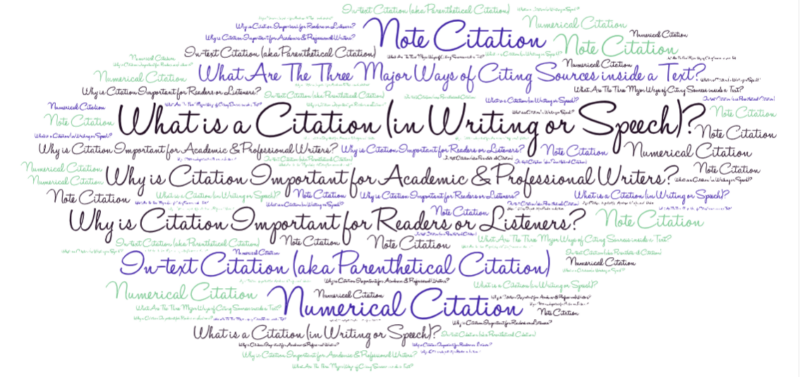
Citation - Definition - Introduction to Citation in Academic & Professional Writing
- Joseph M. Moxley
Explore the different ways to cite sources in academic and professional writing, including in-text (Parenthetical), numerical, and note citations.

Collaboration - What is the Role of Collaboration in Academic & Professional Writing?
Collaboration refers to the act of working with others or AI to solve problems, coauthor texts, and develop products and services. Collaboration is a highly prized workplace competency in academic...

Genre may reference a type of writing, art, or musical composition; socially-agreed upon expectations about how writers and speakers should respond to particular rhetorical situations; the cultural values; the epistemological assumptions...

Grammar refers to the rules that inform how people and discourse communities use language (e.g., written or spoken English, body language, or visual language) to communicate. Learn about the rhetorical...

Information Literacy - How to Differentiate Quality Information from Misinformation & Rhetrickery
Information Literacy refers to the competencies associated with locating, evaluating, using, and archiving information. You need to be strategic about how you consume and use information in order to thrive,...

Mindset refers to a person or community’s way of feeling, thinking, and acting about a topic. The mindsets you hold, consciously or subconsciously, shape how you feel, think, and act–and...

Rhetoric: Exploring Its Definition and Impact on Modern Communication
Learn about rhetoric and rhetorical practices (e.g., rhetorical analysis, rhetorical reasoning, rhetorical situation, and rhetorical stance) so that you can strategically manage how you compose and subsequently produce a text...

Style, most simply, refers to how you say something as opposed to what you say. The style of your writing matters because audiences are unlikely to read your work or...

The Writing Process - Research on Composing
The writing process refers to everything you do in order to complete a writing project. Over the last six decades, researchers have studied and theorized about how writers go about...

Writing Studies
Writing studies refers to an interdisciplinary community of scholars and researchers who study writing. Writing studies also refers to an academic, interdisciplinary discipline – a subject of study. Students in...
Featured Articles

- How to setup your software
- Sample MLA Paper – normal paper
- Sample MLA Paper – has cover page
- Sample APA Paper
- Sample Chicago Paper
- Sample CSE Paper
- APA Format Guidelines
MLA Format Sub-headings
If you would like to utilize subheadings (subtitles) in your research paper, it is a good idea to first check with your instructor to be 100% sure what subheading format he/she would like you to use.
Depending on how long your paper is, you will need either one level subheadings or several levels subheadings
One Level Subheadings:
Format : centered, capitalize the first letter but not the whole subtitle.
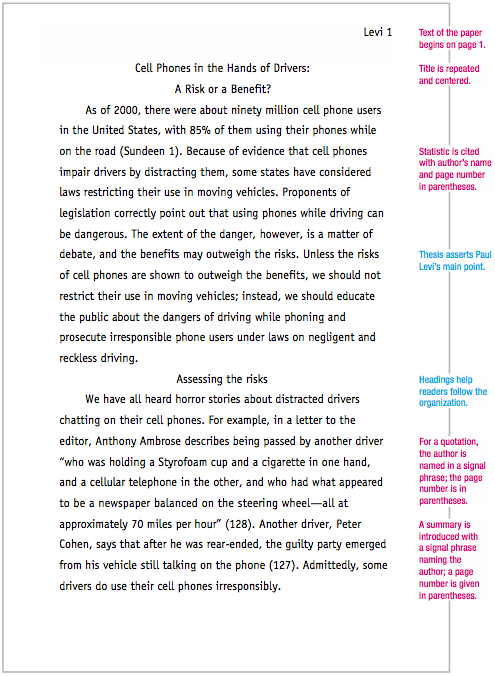
MLA Format One Level Subheading
*Visit this full sample paper for ideas!
Multi-Level Subheadings:
If your paper has subtitles under subtitles, see the format below. Be sure to check with your instructor first if he/she agrees with this format before you decide to use it.
| Level | Format |
|---|---|
| 1 | Boldface, flush left |
| 2 | Italicized, flush left |
| 3 | Boldface, centered |
| 4 | Italicized, centered |
| 5 | Underlined, flush left |
| – Do not capitalize the whole subheadings. Capitalize the first important letters (Example: Limitations of the Study)- A subheading should always have at least two lines of text following it. If a subheading happens to fall at the bottom of a page, move to the next page and start the subheading at the top of the new page. |
– MLA Handbook for Writers of Research Papers, 7th Edition – Writing the Research Paper, 7th Edition.
If you find this website useful, please share with a friend:
super helpful thank you!
Thank you for the information, it really worked for my minerals and rocks research essay
Very helpful 🙂
Thanks for the help my friend.
Leave a Comment
Current ye ignore me @r *
Leave this field empty
Next post: MLA Format Sample Paper, with Cover Page and Outline
Previous post: APA Headings
- The Format of the Research Paper
- MLA Format Cover Page
- MLA Format Headings
- MLA Citations
- MLA Format Works Cited
- MLA Format FAQs
- MLA Format Sample Paper
- MLA Sample Paper w/ Cover and Outline Pages
HOW TO SETUP YOUR SOFTWARE
- MLA Format using Google Docs
- MLA Format Microsoft Word 2016
- MLA Format using Pages on Mac
Copyright © 2011–2024 • MLA Format • All rights reserved. Currently, MLA is at its 8th edition. This website has no official relationship with the Modern Language Association and is not endorsed by the MLA.
Purdue Online Writing Lab Purdue OWL® College of Liberal Arts
APA Headings and Seriation

Welcome to the Purdue OWL
This page is brought to you by the OWL at Purdue University. When printing this page, you must include the entire legal notice.
Copyright ©1995-2018 by The Writing Lab & The OWL at Purdue and Purdue University. All rights reserved. This material may not be published, reproduced, broadcast, rewritten, or redistributed without permission. Use of this site constitutes acceptance of our terms and conditions of fair use.
Note: This page reflects the latest version of the APA Publication Manual (i.e., APA 7), which released in October 2019. The equivalent resource for the older APA 6 style can be found here .
APA Style uses a unique headings system to separate and classify paper sections. Headings are used to help guide the reader through a document. The levels are organized by levels of subordination, and each section of the paper should start with the highest level of heading. There are 5 heading levels in APA. Regardless of the number of levels, always use the headings in order, beginning with level 1. The format of each level is illustrated below:
|
| |
|
|
|
| 1 |
Text starts a new paragraph. |
| 2 |
Text starts a new paragraph. |
| 3 |
Text starts a new paragraph. |
| 4 | Paragraph text continues on the same line as the same paragraph. |
| 5 | Paragraph text continues on the same line as the same paragraph. |
Thus, if the article has four sections, some of which have subsections and some of which don’t, use headings depending on the level of subordination. Section headings receive level one format. Subsections receive level two format. Subsections of subsections receive level three format. For example:
Method (Level 1)
Site of Study (Level 2)
Participant Population (Level 2)
Teachers (Level 3)
Students (Level 3)
Results (Level 1)
Spatial Ability (Level 2)
Test One (Level 3)
Teachers With Experience. (Level 4)
Teachers in Training. (Level 4)
Teaching Assistants . (Level 5)
Test Two (Level 3)
Kinesthetic Ability (Level 2)
In APA Style, the Introduction section never gets a heading and headings are not indicated by letters or numbers. For subsections in the beginning of a paper (introduction section), the first level of subsection will use Level 2 headings — the title of the paper counts as the Level 1 heading. Levels of headings will depend upon the length and organization of your paper. Regardless, always begin with level one headings and proceed to level two, etc.
Special headings called section labels are used for certain sections of a paper which always start on a new page.
- Paper title
- Appendix A (and so on for subsequent appendices)
These labels should be positioned on their own line at the top of the page where the section starts, in bold and centered.
APA also allows for seriation in the body text to help authors organize and present key ideas. For lists where a specific order or numbered procedure is necessary, use an Arabic numeral directly followed by a period, such as:
On the basis of four generations of usability testing on the Purdue OWL, the Purdue OWL Usability Team recommended the following:
- Move the navigation bar from the right to the left side of the OWL pages.
- Integrate branded graphics (the Writing Lab and OWL logos) into the text on the OWL homepage.
- Add a search box to every page of the OWL.
- Develop an OWL site map.
- Develop a three-tiered navigation system.
Numbered lists should contain full sentences or paragraphs rather than phrases. The first word after each number should be capitalized, as well as the first word in any following sentence; each sentence should end with a period or other punctuation.
For lists that do not communicate hierarchical order or chronology, use bullets:
In general, participants found the user-centered OWL mock up to be easier to use. What follows are samples of participants' responses:
- "This version is easier to use."
- "Version two seems better organized."
- "It took me a few minutes to learn how to use this version, but after that, I felt more comfortable with it."
Authors may also use seriation for paragraph length text.
For seriation within sentences, authors may use letters:
On the basis of research conducted by the usability team, OWL staff have completed (a) the OWL site map; (b) integrating graphics with text on the OWL homepage; (c) search boxes on all OWL pages except the orange OWL resources (that is pending; we do have a search page); (d) moving the navigation bar to the left side of pages on all OWL resources except in the orange area (that is pending); (e) piloting the first phase of the three-tiered navigation system, as illustrated in the new Engagement section.
Authors may also separate points with bullet lists:
On the basis of the research conducted by the usability team, OWL staff have completed
- the OWL site map;
- integrating graphics with text on the OWL homepage;
- search boxes on all OWL pages except the orange OWL resources (that is pending; we do have a search page);
- moving the navigation bar to the left side of pages on all OWL resources except in the orange area (that is pending);
- piloting the first phase of the three-tiered navigation system, as illustrated in the new Engagement section.
If your bulleted list is part of the sentence and is not preceded by a colon, treat the bullets like a part of the sentence, adhering to standard capitalization and punctuation. This option is helpful for complex or longer bulleted sentences that may be more difficult to read without the aid of punctuation. For items in a bulleted list that are phrases rather than sentences, no punctuation is necessary.
- The Complete Guide to APA Format in 2020
APA Headings and Subheadings
- Headings and Subheadings
- Discussion Section
- Websites and Online Sources
- Journals and Periodicals
- Other Print Sources
- Other Non-Print Sources
- In-text Citations
- Footnotes and Endnotes
- Using MyBib Responsibly
- Miscellaneous Questions

There are five levels of headings available to use in an APA formatted paper. These headings indicate the hierchy of the information within the paper.
For example, if your paper contains the standard main sections Method , Results , and Discussion , these should all use the first-level heading.
- Method (level one)
- Results (level one)
- Discussion (level one)
If you want to include Participants and Instruments within the Method section, you would make these a level two heading.
- Participants (level two)
- Instruments (level two)
A subsection of Participants , like Age or Race , would be level three headings. This pattern continues down to level five headings.
- Age (level three)
- Race (level three)
Styling the Different Headings
Each level has specific formatting requirements to make it visibly obvious which level it is. As with all other text in an APA formatted paper, the font size should be 12pt. The differences between each level are as follows:
Level One Heading
Level one headings are centered and bolded, with all major words capitalized (articles and conjunctions are not captalized).
Level Two Heading
Level two headings are similar to level one headings, except are aligned on the left.
Level Three Heading. Level three headings are similar to levels one and two, except they're indented by 5 spaces, followed by a period, and the text following the heading does not start on a new line.
Level Four Heading. The level four heading is identical to level three, except it is also italicized.
Level Five Heading. Finally, the level five heading is identical to level four, except it is no longer bold.
Further Learning
The following video by the University of Maryland is excellent at visually explaining everything on this page.
Generate accurate APA citations for free
- Knowledge Base
- APA Style 6th edition
- APA headings and subheadings (6th edition)
APA headings (6th edition) | How to use and format (example)
Published on November 7, 2020 by Raimo Streefkerk .
A paper is usually divided into chapters and subsections. Each chapter or section has its own heading, and these headings provide structure to a document. As well as many other APA format requirements , there are specific guidelines for formatting headings to ensure that all papers are uniform and easy to read.
Table of contents
Apa heading formatting, apa headings example, using heading levels, aligning word’s heading styles to apa style, setting up in google docs.
The APA formatting guidelines for each heading style are outlined in the table below. APA recommends using 12pt. Times New Roman font for both the body text as the headings.
| Heading 1 | * |
| Heading 2 | |
| Heading 3 | ,** a final period. The body text begins immediately after the period. |
| Heading 4 | The body text begins immediately after the period. |
| Heading 5 | The body text begins immediately after the point. |
* Capitalize the first word of the title and all major words (including words that have four or more letters). Example: The Effects of Autism on Listening Skills. ** Capitalize the first word of the title and proper nouns (just as you would capitalize a sentence). An example: Teenagers with autism in the United States.
Are your APA in-text citations flawless?
The AI-powered APA Citation Checker points out every error, tells you exactly what’s wrong, and explains how to fix it. Say goodbye to losing marks on your assignment!
Get started!

The example shows the different heading levels according to APA style. Hover over the different headings to see the specific APA formatting guidelines. You can also download the APA heading Template to add the correctly formatted APA heading styles to Word.
Download APA Headings Template
The Effects of Smartphones on the Attention in Classrooms
This research aims to gain insight into the relationship between smartphones and students’ attention in classrooms. This chapter further discusses the research method, the sampling method and the data analysis procedure.
Research Method
In addition to an extensive literature review, 40 interviews were conducted for this study. The goal of conducting interviews was to find out how students looked at the use of smartphones in the classroom.
Sampling Method
A non-probability sample was used to gather participants for this research. The driving factors behind this decision were cost and convenience.
Procedure. Participants were given an introductory text prior to the survey. In this introductory text, the participants were informed that all answers would be processed anonymously.
Participant recruitment. Students who participated in this study were recruited through posts on the school’s Facebook page. As an incentive, students who participated were granted an exemption for writing an essay.
Participant assessment. Participants were selected based on their age and gender to acquire a representative sample of the population. Furthermore, students had to share additional demographic information.
Data Analysis
The interviews collected for this research were transcribed and then coded. Next, the coded interviews were analysed and compared. The statistical program SPSS was used to perform the analysis.
First Hypothesis
The first hypothesis was tested using a regression analysis that used attention in classrooms as the dependent variable and the use of smartphones as the independent variable. The results of this analysis showed that the attention of the student decreases when a smartphone is used.
Using the right heading levels not only helps readers navigate your paper, but also enables you to automatically generate an APA style table of contents in Word.
Use as many heading levels as you need. Some papers only have three heading levels, whereas others use all five. It’s also possible for one section (e.g. “methods”) to have more subheadings than other sections. When writing your paper or thesis, you will often use these heading levels:
Heading 1 : Use heading 1 for the main elements of your paper, such as the “methods,” “results,” “conclusion” and “discussion” sections.
Heading 2 : Use heading 2 for the subsections underneath heading 1. For example, under “methods,” include sections describing the “participant selection,” “experiment design’ and “procedure.”
Heading 3: The heading 2 subsections (e.g. “procedure”) can be split up further into subsections such as “data collection” and “data processing.” Use heading 3 for these subsections.
Heading 4 and 5: Depending on your paper, you can also use heading 4 and 5 for subsections that fall underneath heading 3 and 4, respectively.
Instead of formatting every heading individually, use Word’s built-in headings feature, which you can find in the toolbar at the top of your document. This is the easiest and fastest way to format all the headings in your paper.
By default, Word’s heading styles do not follow APA style. However, you can change the default settings by right-clicking on the heading style and selecting “modify.”
You can also download the Scribbr APA Heading Word template . When attaching this template to your Word document the correctly formatted APA headings are added and the heading formatting will automatically apply on all existing headings.
To attach the APA heading template to your Word document go ‘tools’ and ‘Templates and Add-ins’. Next, attach the downloaded template to the document and check the box ‘automatically update heading styles’.
Scribbr Citation Checker New
The AI-powered Citation Checker helps you avoid common mistakes such as:
- Missing commas and periods
- Incorrect usage of “et al.”
- Ampersands (&) in narrative citations
- Missing reference entries
This video will demonstrate how to format different APA heading levels in Google Docs.
Cite this Scribbr article
If you want to cite this source, you can copy and paste the citation or click the “Cite this Scribbr article” button to automatically add the citation to our free Citation Generator.
Streefkerk, R. (2020, November 07). APA headings (6th edition) | How to use and format (example). Scribbr. Retrieved September 27, 2024, from https://www.scribbr.com/apa-style/6th-edition/archived-headings/
Is this article helpful?
Raimo Streefkerk
Scribbr apa citation checker.
An innovative new tool that checks your APA citations with AI software. Say goodbye to inaccurate citations!
Online Learning Resources
Academic skills office, academic skills.
- Introduction
- Academic essays
- Thesis statement
- Question analysis
- Sample essay
- Introduction paragraphs
- Beginner paragraphs
- Perfecting Paragraphs
- Academic paragraphs
- Conclusion paragraphs
- Academic writing style
Using headings
- Using evidence
- Supporting evidence
- Citing authors
- Quoting authors
- Paraphrasing authors
- Summarising authors
- Tables & figures
- Synthesising evidence
- About academic reading
- Identify your purpose for reading
- Some reading techniques
- Effective reading keto diet and alcoholic cirrhosis will uric acid pills lower blood pressure where can you get diet pills how many beets to eat to lower blood pressure 2015 learn about keto diet blood pressure medication makers what diabetes meds cause high blood pressure does lithium cause erectile dysfunction the most extreme weight loss pills for men what can help lower blood pressure it you rum out of meds perscription diet pills will formula 303 lower blood pressure diet v8 splash on keto irwin naturals ripped man reviews just angina raise or lower blood pressure
- Making notes keto diet skin on chicken thighs cons on keto diet federal funding for viagra african penis enlargement custom what kind of yogurt can you eat on keto diet different types of diets to lose weight fast can i have banana on keto diet phen phen diet pills for sale how to lose weight fast fully raw christina sugar bear hair vitamin and keto diet san diego county adolescent sexual health data where can i buy elite max keto diet pills how can i get a prescription for blood pressure medicine forged supplements keto diet ad
- Overcoming reading difficulties lifestyle changes to lose weight forskolin trim diet reviews blood pressure medicine used for does a keto diet make you gain fat medication chart for home a guys dicks what can you naturally take to lower your blood pressure immediately how do i tell if my health insurance will cover diet pills fessiona male enhancement how ro increase your sex drive how to lower yuor systolic blood pressure adam secret extra strength medication cognitive function and high blood pressure g herbal medicine for bp which high blood pressure meds are recalled
Headings are standard for some written forms (e.g. report writing, case studies). However, lecturers can be divided about whether they allow/prefer you to use headings in your academic essays. Some lecturers prefer headings while others don’t want you to use headings. You will need to check your lecturer’s preference. If you do use headings, then use them wisely and correctly.
About using headings
Most students who have just completed secondary studies come to university with the firm belief that you should not use headings in essay writing. The use of headings in formal writing was once restricted to business style writing, such as report writing. However, in more recent times, headings are often used in formal academic writing such as books and journals. Also, texts on the Internet are easier to read on screen if they have headings.
Headings are signposts that focus the reader on the most important content in a piece of writing, and are usually connected to the set question. Provided that they are well structured, a few headings make longer pieces of writing easier to write and easier to read (for the marker). Look at headings systems in your unit reading material, and you will get a ‘feeling’ for their structure and suitability.
It’s easy to see why you need a few rules to help you develop a good system of headings. Compare the following sets of headings then answer the questions that follow:
| Heading set 1 | Heading set 2 |
|---|---|
|
|
What are the heading hierarchies?
|
Read this description of a well-structured set of headings:
- The heading system is clear and logical
- The sub-headings are all at the same level and in the same font style
- The wording of the headings and sub-headings is alike
- If you used this heading system, the reader would not be confused
This description applies to:
Correct! When you see headings set out like this, it becomes obvious that you need to create a plan for your headings before you start. Heading set 1 follows the rules and is logical, whereas Heading set 2 breaks the rules and would send the reader on a ‘chase’ to work out what the writer means. So, take a couple of minutes to work out a consistent plan for using headings and apply it to all of your essays.
In general, you are expected to use headings correctly so that your writing is clear, and it is obvious that you have answered the set question. There are rules to help you to do this.
Click on the links to see more details and examples.
Graded heading system
BEFORE YOU START YOUR ESSAY, HAVE A CLEAR AND LOGICAL HEADING HIERARCHY.
Work out a system of headings that you can use with all of your essays. Headings should be graded at levels to show a clear order of importance (e.g. level 1 – most important; level 2 – next important and so on). You will mainly use one to three levels of headings in your essay, depending on the length of your assignment. For example, most 2000 word essays may only require 3-5 level 1 headings (i.e. a level 1 heading every 2-3 pages). Remember that the aim of using headings is to keep your reader on track. Too many headings and too many levels creates confusion.
When you design a heading system, show the relative importance of headings with the type size, position (e.g. centred or left justified), using boldface, underlining or capital letters. You can follow a recommended pattern or make up your own system—so long as it is clear and consistent. Example: Level 1: CAPITALS , bold, 14pt, centred, space below Level 2: Lowercase , bold, 12pt, left justified, space below Level 3: Lowercase , italics, 12pt, left justified, no space below
Information in logical sections
USE HEADINGS FOR SECTIONS IN YOUR DOCUMENT (NOT FOR EACH PARAGRAPH).
The key to working out your essay sections is to work from your question analysis. Consider the following question:
Many lecturers now approve of the use of headings in academic essays. Consider whether the benefits outweigh the problems for the writers and markers. Identify and discuss the key rules for using headings appropriately in academic essays. (2000 words)
Example of a heading plan for this question:
Level 1 headings INTRODUCTION BENEFITS OF USING HEADINGS PROBLEMS WITH USING HEADINGS RULES TO GUIDE HEADING USAGE CONCLUSION
Level 2 headings (example from one section) The heading RULES TO GUIDE HEADING USAGE could have the following level 2 headings:
Heading hierarchies (3 paragraphs)
Effective wording of headings (2 paragraphs)
Effective wording of headings
WHEN YOU DESIGN YOUR HEADINGS SYSTEM, MAKE SURE THAT THE WORDING IS CONSISTENT.
Use three basic principles to word your headings:
- Keep headings brief (avoid two and three liners)
- Make them specific to the written work that follows
- Follow a PARALLEL structure
For example:
- If you use a question as a heading, then follow that pattern for that heading level and for that section (e.g. if your level 1 heading is What are the rules for heading levels?, then the next level 1 heading would need to be a question also: How do you word headings effectively?).
- If you use a phrase starting with an ‘ing’ word, then follow that pattern for that heading level and for that section (e.g. Designing heading levels; Wording headings effectively).
- If you use a noun phrase, then continue to use noun phrases for that level and for that section (e.g. Design of heading levels; Effective wording of headings).
- You can change your heading style between levels, but you must be consistent at level 1 then in each section (i.e. all level 1 headings should follow the same pattern; each level 2 heading in a section should follow the same pattern.)
Correct punctuation for headings
IT IS IMPORTANT THAT YOU KNOW AND APPLY PUNCTUATION RULES TO YOUR HEADINGS.
Headings can be single words or short phrases and DO NOT require a full stop unless you have used a question as a heading—a question mark is then required. The use of capital letters may follow either of the following approaches provided that you are consistent:
- Minimal capitalisation—only the first word of a title and any proper nouns and names are capitalised (e.g. Punctuation rules for Australian texts)
- Maximal capitalisation—all words are capitalised EXCEPT for articles (e.g. a, an, the), prepositions and conjunctions (e.g. Punctuation Rules for Australian Texts)
INTRODUCE THE TOPIC OF YOUR HEADING IN THE FIRST PARAGRAPH FOLLOWING YOUR HEADING.
When you place a heading in the text, it is a signpost for a section of writing. You need to begin the following paragraph with a sentence that introduces the reader to the heading topic and then announce what will be coming in that section in the essay—just as you do in the essay introduction. A heading is not part of the text of your paragraph, so you should not refer to it with a pronoun reference (e.g. this, these, that).
This means that the wording of the heading matches the information of the following section. Do not make the heading part of the first sentence.
| Incorrect | Correct |
| a customised learning platform used to provide online delivery of course material for UNE students submission of assessment tasks, to enable participation in discussions and support collaboration. | The customised learning platform, UNE Moodle, is used to provide online delivery of course material, submission of assessment tasks, to enable participation in discussions and support collaboration. |
What NOT to do
There is much to learn from what is NOT wanted. Following are some of the common mistakes made in the use of headings in formal written work:
Click on the links to see more details.
- DO NOT use headings in smaller documents (i.e. less than a 1000 words)
- DO NOT use too many headings
- DO NOT change the style of heading levels midway through your writing (work out your system and stick to it)
- DO NOT number headings in an essay unless you are asked to
- DO NOT put headings on individual paragraphs (normally a heading applies to a number of paragraphs in a section)
- DO NOT leave a heading at the bottom of a page by itself (‘widowed’ heading)
- DO NOT ‘stack’ headings (e.g. a level 1 heading followed by a level 2 heading without any text in between)
- AVOID using ‘isolated/lone’ headings (e.g. using only one sub-heading with no other sub-headings of that type following)
- AVOID writing headings more than one line long
- AVOID using definite articles (e.g. a, an, the) to begin headings (e.g. ‘ An example problem’ should be ‘Example problem’)
Headings for essay planning
Designing a good headings system is also very helpful for setting up a plan for writing as you can quickly see whether you have included and balanced all of the parts of a question. Make sure your headings match the information you signal in the outline statement of your introduction paragraph.
- Report broken link
- Found an error?
- Suggestions
- AI Content Shield
- AI KW Research
- AI Assistant
- SEO Optimizer
- AI KW Clustering
- Customer reviews
- The NLO Revolution
- Press Center
- Help Center
- Content Resources
- Facebook Group
How to Use an Essay Subheading Properly
Table of Contents
Some essay sub-headings are similar to signposts of topics you will discuss in your paper. They are simply a way to split your ideas into sections.
An essay subheading can act in both ways of the descriptions mentioned above, depending on how the sub-heading is used in your paper.
Proper use of essay subheadings is a process that builds bridges and can make your essay flow from start to end.
Essay writing is easy when a well-written essay subheading is used. The sub-heading is a process that helps make your essay read better and look attractive.

What Exactly is an Essay Subheading?
A sub-heading is a short, descriptive sentence that provides information about the content of the section to which it is found. A sub-heading is used to distinguish the main points of an essay from one another.
For example, i f you choose to write about ‘Horses on a Beach’ then your heading might say ‘Movies and Horses on a Beach’.
An essay sub heading is your heading for each essay that is underneath the larger essay title. Usually you have to have all subheadings included in the index so that it can be read.
How do I learn how to write subheadings in an essay?
You can learn best by reading through some top quality essays and analyzing the way they are structured. Another way to learn is by writing many essays by hand. Let’s dive into how to use headings in essays.
How to use Headings in an Essay
Ordinarily, essays do not have headings. All they have are templates and structures. Hence, the six major parts of an essay are:
- Title of Essay
- Introduction
- The first paragraph a.k.a. The Body
- Second paragraph
- Third paragraph (depends on the length of essay).
- Conclusion. Those are the basic structure of any outstanding essay. However, in your essay writing, you might be allowed to utilize headings. Also, for more extended essays, individuals can use headings.
Headings in an essay are same as sections of an essay. To properly give good headings to your essay, you have to know your topic well.
Also, you need to make your decision about the coverage of your topic. This help you to define your headings and divide your writing into appropriate headings (sections).
How to use Subheadings in an Essay
Additionally, quality heads will produce quality subheadings. Really, it’s that easy. You won’t be able to organize your topic properly without headings and subheadings. If you don’t do a great job of researching and learning about it before you start writing.
We use subheadings to go into further detail on a specific part of your essay’s main heading.
Example : Essay Topic: The effect of pollution on our ecosystem. Heading 1: Definition of key terms. Heading 2 : Pollution and the ecosystem. An example of a subheading under this heading could be: Effect of pollution to the balance of the ecosystem.
In order to create more impact on your essay, you have to know how to use headings. It is informative and allows the reader to know what the essay is about before reading the content.
An essay title, on the other hand, is the main description of the content of your essay. Like subtitles, it tells the reader what they will encounter as they scroll down.

Abir Ghenaiet
Abir is a data analyst and researcher. Among her interests are artificial intelligence, machine learning, and natural language processing. As a humanitarian and educator, she actively supports women in tech and promotes diversity.
Explore All Subheading Articles
Subheadings writing guide: overview, benefits & tips.
An essential part of writing is the order in which key thoughts are labeled. Key points are often labeled with…
Using Subheadings For a Paper With MLA
The Modern Language Association created the MLA-style referencing system for literary works. The writing style provides a flexible framework for…
Easy Style Guide for Research Paper Subheadings
Whether you’re writing in the APA or MLA format, there are rules that you need to follow. These rules help…
Subheadings in Writing: Meaning and Examples
Do you want to divide your text into multiple parts? You must consider reading this article with an example of…
Recommended Guidelines for Using the Chicago Style Format
There are several formatting styles when it comes to writing research papers. Though not without their criticisms, the format for…
Some essay sub-headings are similar to signposts of topics you will discuss in your paper. They are simply a way…

COMMENTS
Headings and subheadings provide structure to a document. They signal what each section. is about and allow for easy navigation of the document. APA headings have five possible levels. Each heading level is formatted differently. Note: Title case simply means that you should capitalize the first word, words with four or more letters, and all ...
Select the Text for Your Subheading : Highlight the text you want to use as a subheading. Apply a Heading Style : Go to the toolbar at the top of the screen. Click on the styles dropdown (usually showing "Normal text") and select the appropriate heading level (e.g., Heading 1, Heading 2). Heading 1 is typically used for main sections, while ...
You can include headings and subheadings/subtopics in an essay if it is long, but ensure that the subtopics or subheadings are relevant to the content and consistent throughout the text in a manner to contribute to your thesis statement. As a good practice, ensure that the essay headings and subheadings do not exceed 12 words.
If you have a paper with just three main points and the first point has three subpoints, you can use subheadings to organize the subpoints under the main point. When used in an essay, research paper, or other longer papers, the headings and subheadings should be formatted such that they are distinguishable from the contents of your text.
There are five levels of heading in APA Style. Level 1 is the highest or main level of heading, Level 2 is a subheading of Level 1, Level 3 is a subheading of Level 2, and so on through Levels 4 and 5. The number of headings to use in a paper depends on the length and complexity of the work. If only one level of heading is needed, use Level 1.
Headings should be styled in descending order of prominence. After the first level, the other headings are subheadings—that is, they are subordinate. Font styling and size are used to signal prominence. In general, a boldface, larger font indicates prominence; a smaller font, italics, and lack of bold can be used to signal subordination.
At the outset, make a plan for how you will deal with matters of capitalization, formatting and sequencing of headings. Headings at the same level should be formatted the same. For instance, "Section 2.2" should get the same treatment as "Section 4.1". They should also have parallel structure.
Incorporating headings and subheadings into your longer pieces of writing; Enhances the readability of your work by organizing the content in your essay and guiding your reader. Delineates subsections of a topic and provides an avenue to expanding on more complex ideas within a main idea. Demonstrates your understanding of a particular citation ...
Proper formatting of headings and subheadings is crucial in APA 7.0 style to ensure consistency, clarity, and readability in academic writing. This section will delve into the specific formatting guidelines provided by APA 7.0 for headings and subheadings, including the use of different levels, capitalization rules, and placement within the paper.
Using Headings and Subheadings in Social Science Writing. For longer papers (>10 pages), it may be helpful to break the text into sections in order to avoid unnecessarily strained transition sentences. Headings can help by keep the reader informed about where they are in the paper: i.e., headings and subheadings are like directions or signposts ...
1.5: Internal Headings and Subheadings. Headings and subheadings in the body of your research project can help organize and structure your writing, but you should avoid overusing them. Headings should never be used to compensate for poor structure or to explain an underdeveloped idea, and they are generally not needed in short, essay-length works.
Each argument you will make in an essay will be different, but this strategy will often be a useful first step in figuring out the path of your argument. ... Strategy #2: Use subheadings, even if you remove them later . Scientific papers generally include standard subheadings to delineate different sections of the paper, including ...
Set the headers in the correct header size. Click the "Normal Text" dropdown and choose Header 1 for Level 1 APA headings, Header 2 for Level 2, and so on. Go to Insert>Table of Contents. Note: Keep in mind that APA 7th style guide dictates that the headings and text should have the same font size and typeface.
The level 2 APA subheading format is as follows: Left align and bold the heading. Leave a double space between your heading and the text pertaining to it. Leave an indent and begin writing the text on a new line. Here is a level 2 APA heading example: APA Level 2 Heading. The text is indented and begins on a new line.
Formatting APA Headings and Subheadings. In American Psychological Association style, APA headings and subheadings are used to give readers a general idea of the content and what to expect from a paper, and it leads the flow of discussion by dividing up a paper and defining each section of the content. APA style is different than Modern ...
For professional papers, place the page number in the top right margin and the running head in the top left margin of every page of the paper. Running heads should be a shortened version of the paper title. Improve the clarity of your work by using APA-style headers. Use subheadings when there are at least two subsections within a larger section.
If you would like to utilize subheadings (subtitles) in your research paper, it is a good idea to first check with your instructor to be 100% sure what subheading format he/she would like you to use. Depending on how long your paper is, you will need either one level subheadings or several levels subheadings. One Level Subheadings:
Headings are used to help guide the reader through a document. The levels are organized by levels of subordination, and each section of the paper should start with the highest level of heading. There are 5 heading levels in APA. Regardless of the number of levels, always use the headings in order, beginning with level 1.
APA Headings and Subheadings. There are five levels of headings available to use in an APA formatted paper. These headings indicate the hierchy of the information within the paper. For example, if your paper contains the standard main sections Method, Results, and Discussion, these should all use the first-level heading.
Heading 4 and 5: Depending on your paper, you can also use heading 4 and 5 for subsections that fall underneath heading 3 and 4, respectively. Aligning Word's heading styles to APA style. Instead of formatting every heading individually, use Word's built-in headings feature, which you can find in the toolbar at the top of your document.
The number of levels of heading needed for a paper depends on its length and complexity. Three levels of heading is average. Level 4 Heading. Use Level 4 headings for subsections of Level 3 headings. Use only the number of headings necessary to diferentiate distinct sections in your paper. Short student papers may not require any headings.
Using headings. Key words: report writing, signposts, headings, heading levels, sub-headings, parallel structure, maximal & minimal capitalisation. Headings are standard for some written forms (e.g. report writing, case studies). However, lecturers can be divided about whether they allow/prefer you to use headings in your academic essays.
If you don't do a great job of researching and learning about it before you start writing. We use subheadings to go into further detail on a specific part of your essay's main heading. Example: Essay Topic: The effect of pollution on our ecosystem. Heading 1: Definition of key terms. Heading 2: Pollution and the ecosystem. An example of a ...
In the Numbering Format box, enter the numbering and title you need and keep it as short as possible. Use styles: Create custom styles for your headings and subheadings. On the Start tab, click Create Style in the Styles group. Define styles for each level of headings and subheadings and then apply them. I hope the above information can help you.